- Home
-
SHOP ECO FARM
- ECO Farm Grow Lights
- ECO Farm LED Grow Lights
- ECO Farm Quantum Board
- ECO Farm Samsung LED Grow Lights
- ECO Farm COB Grow Lights
- ECO Farm Commercial Lights
- ECO Farm Supplemental Grow Light
- ECO Farm Fluorescent grow lights
- ECO Farm HPS & MH Grow Lights
- ECO Farm CMH Grow Lights
- ECO Farm HID/CMH Bulbs & Ballasts
- ECO Farm Grow Tents & Kits
- ECO Farm 2x2ft Grow Kits
- ECO Farm 3x3ft Grow Kits
- ECO Farm 3.3x3.3ft Grow Kits
- ECO Farm 4x4ft Grow Kits
- ECO Farm 5x5ft Grow Kits
- ECO Farm Grow Tent - Standard Style
- ECO Farm Grow Tent - Extension & Roof & Lodge Style
- ECO Farm Extraction & Harvest
- ECO Farm Rosin Press Machine
- ECO Farm Dry & Wet Trimmers
- ECO Farm Oil Accessories
- ECO Farm Medicinal Plants Grinder
- ECO Farm Medicinal Plants Containers
- ECO Farm Medicinal Plants Dryer
- ECO Farm Refrigeration Dryer
- ECO Farm Climate Control & Other Accessories
- ECO Farm Inline Duct Fans
- ECO Farm Oscillating Fans
- ECO Farm Exhaust Fans
- ECO Farm Air Filter
- ECO Farm Duct Muffler
- ECO Farm Ventilation Kits
- ECO Farm Plant Humidifiers
- ECO Farm Plant Dehumidifiers
- ECO Farm Hydroponic Accessories
- ECO Farm Other Accessories
- ECO Farm Hydroponics Microscopes
-
TOP BRANDS
- Grow Lights Brands
- Adjust-A-Wing
- Apollo Horticulture
- Bestva
- Black Dog LED
- California Lightworks
- ChilLED Grow Light
- Eco Farm
- HLG - Horticulture Lighting Group
- Kingled
- Kind LED
- Mars Hydro
- Morsen
- Neilo
- NextLight
- Phlizon
- PlatinumLed
- Roleadro
- Optic LED Grow Lights
- ViparSpectra
- Vivosun
- EYE Hortilux
- IPOWER
- NanoLux
- Phantom grow light
- Gavita grow lights
- Grower's Choice
- Lumatek
- Maxibright
- Yearld Pro
- ThinkGrow
- Crecer Lighting
- Green Sunshine Electric Sky
- fohse aries
- loriflux
- luxx
- fluence
- iluminar
- Lex
- LTC
- Rayonled
- FGI
- PHOTONTEK
- Grow Tents & Kits Brands
- Apollo Horticulture
- Black Box
- CoolGrows
- Eco Farm
- GrowLab
- Gorilla Grow Tents
- Mars Hydro
- Quictent
- Secret Jardin
- Unit Farm
- TopoGrow
- VIVOSUN
- Topolite
-
COMPANY INFO
-
COOPERATE WITH US
- Blog
2022 Best Small LED Grow Lights For Indoor Plants
July 16, 2022
When you realize that your plants aren’t getting all the natural light they need, considering the various grow light options that are out there is a good first step. From there, it probably won’t take long until you find out about the existence of LED grow lights, as there’s a reason they’re the most popular type of grow light. But surely they’re the same as the LED lights you already have at home, just more expensive?
After all, what is the difference between LED lights and LED grow lights? Can’t any LED light be used as a grow light?
Well, not quite. When your goal is to ensure your houseplants grow thicker or start to bloom, it’s important to be aware of not only the different types of grow lights out there, but how they differ to their more standard variations. And as you’ll see, while it’s true that an LED grow light may cost slightly more than a regular light bulb, the benefits more than make it worthwhile.
Advantages of LED Grow Lights
In the early days, technology was impractical and cost-inefficient. But in recent times, the newest technology has increased production, due to which it has become cost-effective. These are energy-efficient plant growth lamps and come with a shorter life span. However, as a result, it makes them costlier in the long run. Sometimes, the heat emitted by HPS lamps is lucrative in greenhouse settings, but these can make them useless for vertical farms or growth chambers.
On the other hand, these are more compact and faster switching, making them ideal for the environment. Moreover, these release less incandescent heat, affecting plants’ moisture and nutrition requirements. Compared to the conventional HPS models, the benefits of the revolutionary models are as follows:
Economic Electricity Consumption:
The LED grow lights for indoor plants use up 50% of the energy used by HPS systems. According to a few experts, they anticipate higher LEDs efficiency shortly.
More Extended Lifespan/Lamp Durability:
They are more long-lasting than the HPS ones. When it comes to HPS lamps, the lifespan is usually one year, whereas, for LEDs, the lifespan is up to 8 years or about 50 000 hours of use.
Smaller Spaces Convenience:
You can set them closer to the plants. However, the growing space should not be extremely high or wide.
Energy Efficiency:
Using them, you can optimize the spectrum while concentrating energy on the wavelengths. These are lucrative for every application and plant. Moreover, the decreased heat production lets you put LED fixtures near plants, ensuring that you have lost less light elsewhere.
Fire Safety:
You can use them safely as these don’t become warm as the conventional HPS lamps.
Dimming:
Mostly, HPS lamps use the full light intensity, whereas these dim. It is possible with a remote control or via an app. As a result, you can handle it easily apart from consuming less power.
Better Crops:
LED grow lights for seedlings can generate better crops to get bigger plants and allow them to grow fast than the HPS ones. In addition, these consist of a spectrum aimed at a specific goal, including anthocyanin accumulation, flowering inhibition, enhanced rooting, etc.
More Environment Safety:
These emit less heat. Besides, you can add UV light to these lamps, reducing bacteria and mold formation probability. It indicates that you will have fewer pesticides and less environmental pollution.
ECO Farm FLD 200W Full Spectrum Dimmable LED Grow Light
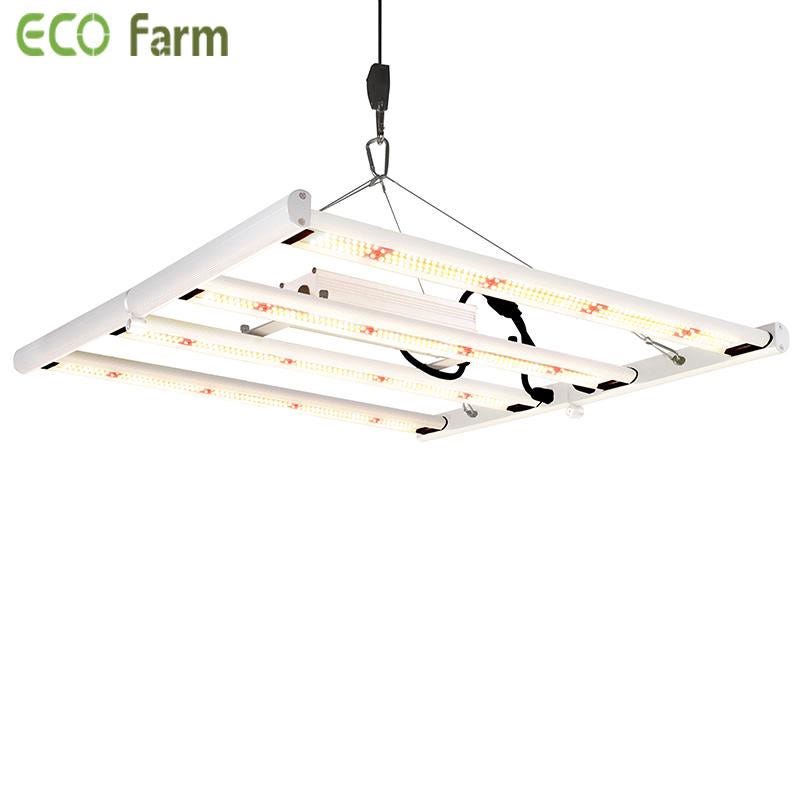
Features:
When compared to other led grow lights, ECO Farm LED grow light uses 800 LED chips that consume only 200W, with perfect coverage for 2x3ft. Don’t settle for cheaper, weaker indoor plant lights. This full spectrum grow light have been used by customers for their beautiful indoor plants. Yield Max spectrum with SMD leds spectrum is white 3000K leds, white 5000K leds, 660nm red leds and 740nm IR leds, Speed up Blooming & Fruiting, Perfect for Density Buds. ECO Farm Indoor Grow Light is a Scalable Solution for Commercial, Home, Grow Tent, Grow room, Hydroponic, Soil full-cycle growing. The first choice for beginners and professional growers, Easy to Install, Ideal for High PPFD Cultivation with Single or multi-tier racking. Yield Max Spectrum and Secondary Optic Reflective Bars, Increase Your Yields & Profits 50% Without Any Extra Energy Costs.
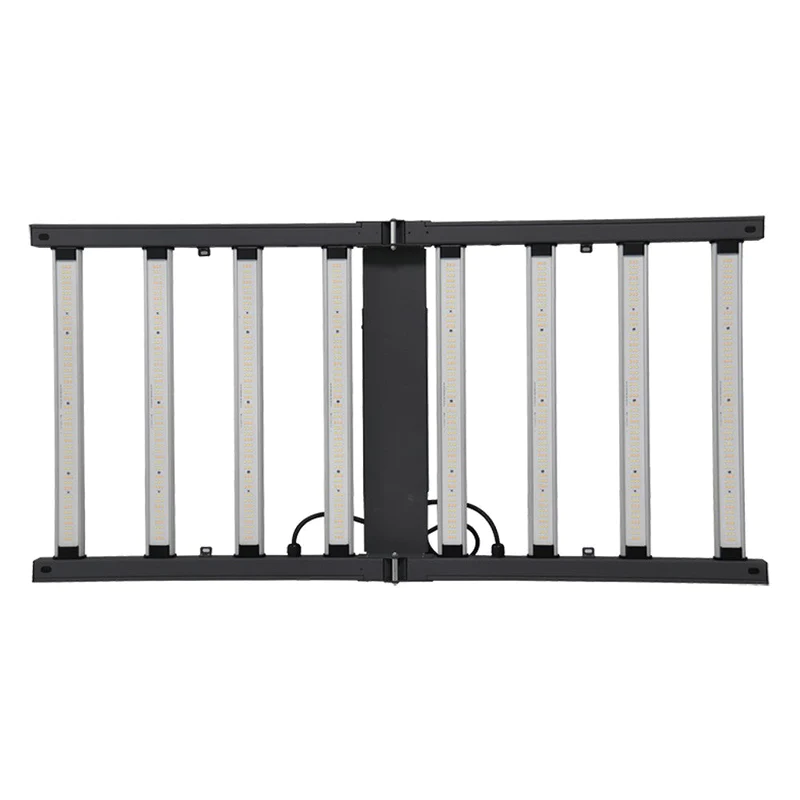
Features:
Operating at just 240W, the GrowPros LED Grow Light is an LED rack lighting solution designed for commercial indoor and greenhouse applications that controls the plant cycle and is especially optimized for plant growth stages. The HM240 series has a crop yield of 1.8 grams per watt (dry). High PPFD and PAR indicate high efficiency, or light output per unit of power consumption. Compared to traditional HID and HPS light sources, the HM240 saves about 50% energy, and you can save a lot of energy over time. Thanks to the passive cooling thermal management system, the HM240 series systems run cooler, meaning your lighting system will last longer while maintaining high light output levels.
BESTVA BAT W200 Dimmable LED Grow Light
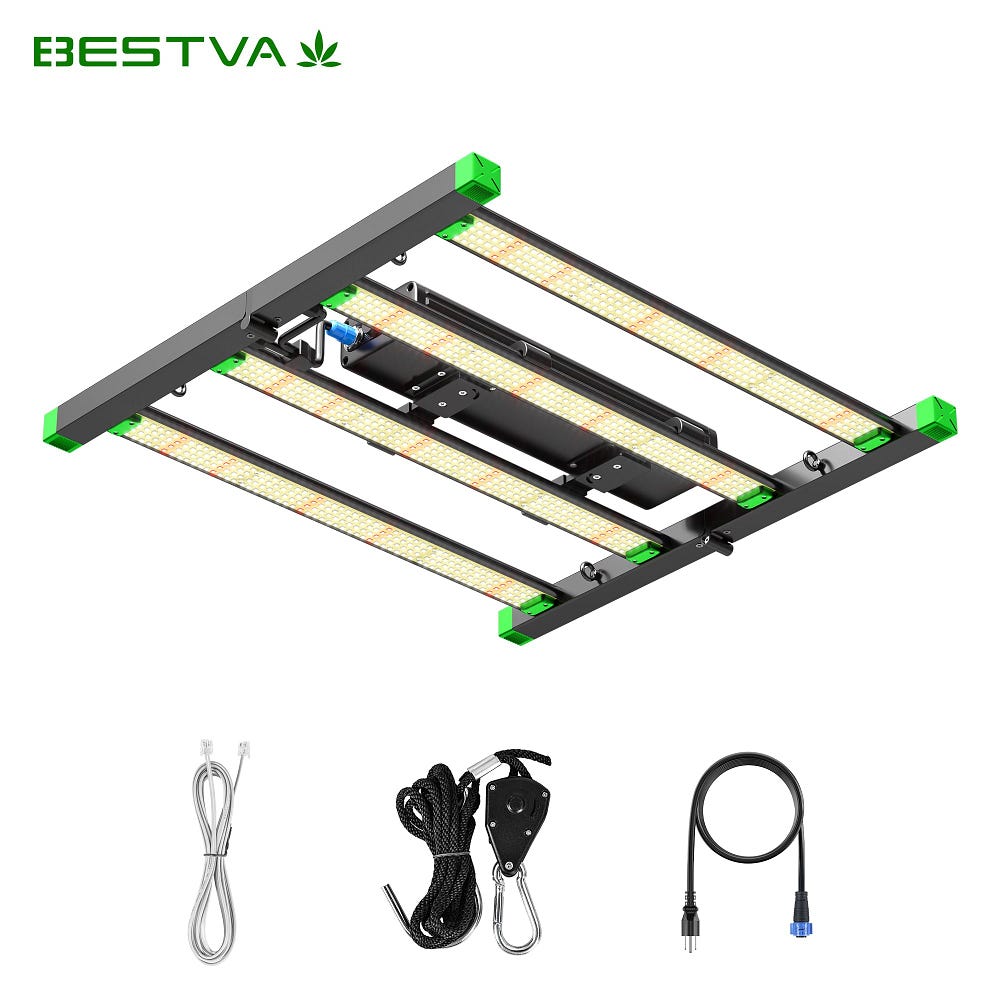
Features:
BESTVA grow light provides highly efficient full spectrum with a healthy red-to-blue ratio to drive photo synthesis. Light energy between 500–599nm, previously thought wasted, penetrates deeper into the plant canopy promoting photo morphogenic responses. High color rendering “white” light aids to rapidly identify potential threats to your crop and provides superior working conditions and safety for personnel. Ideal for both flowering and vegetative production. Bar light design and aluminium material on the back contribute to better airflow and great heat dissipation. This growing light comes with a detachable driver and long power cord, thereby reducing ambient heat in your growing space for extended lifespan. With the waterproof circuit board, worry free of the moist environment. Easy installation.
How to Choose the Best Full-Spectrum Grow Lights?
Purchasing grow lights is not always a walk in the park. If you want more information on growth light specifications, you’ve come to the right place. The following buying guide covers everything you need to know before you set out to find grow lights for your operation.
Light Strength
Before you can begin shopping, you will need to know your target growth light intensity.
Consider the Light’s PPF Rating
The PPF, or photosynthetic photon flux, is the number of light photons that are produced by a light fixture each second. PPF is measured using a PAR, or photosynthetic active radiation, meter. The measurement is then expressed in umols per square meter per second. An ideal PPF rating ranges from 400 to 700 nanometers.
Check the PAR Findings
PAR, or photosynthetic active radiation, is the wavelength of light within the visible range. This figure starts at 400 nanometers and ends at 700 nanometers. Your target PAR depends on the type of plants you are growing as well as the distance of your lights from your plants.
Common vegetables, including tomatoes and lettuce, require 400 to 500 umols/m2/sec. Meanwhile, the recommended PAR level for indoor plants is 300 to 400 umols/m2/sec.
Few plants require more than 1,000 µmols/m2/sec of PAR. In most cases, a light that offers 500 to 1,000 umols should be sufficient. You can usually get away with lower PAR ranges during early growth stages. Meanwhile, more powerful PAR ranges are needed during flower and fruiting.
Analyze the PPFD
PPFD, or photosynthetic photon flux, is a unit of measurement used to describe light intensity in a specific area. Or, in other words, it is the amount of light that falls on the PAR region of your growing area every second. As we already know, plants need 500 to 1,000 umols of PAR per square foot per second.
PPFD is sometimes confused with PPF. However, PPFD is the amount of light that actually impacts plants. Whereas, PPF is the amount of light produced by a fixture.
Spectrum
Light spectrum is yet another key factor concept that you need to understand before you select the right grow light. A qualifying light needs to offer a full spectrum of light colors to promote photosynthesis (chlorophyll absorption). Most growing experts recommend a full-spectrum fixture that offers a ratio of blue and red light as well as some UB and far-right radiation (photomorphogenesis. This spectrum usually covers the full photosynthetically active radiation range (PAR) or 400 to 700 nanometers.
Virtually every stage of the plant life cycle is dependent on targeted light wavelengths. This includes fruiting potential, flowering yield, vegetation growth, root growth, harvest characteristics, and harvest yield.
Blue light, which also falls within the 100 to 400-nanometer range, can determine the vegetation development, root development, and flower development of plants grown indoors. Meanwhile, red light (600 to 700 nanometers) improves plants’ photosynthesis and biomass. The UV wavelength, which ranges from 100 to 400 nanometers, is responsible for flavor and photosynthesis.
Most plants come with a recommended blue to red ratio. For example, lettuce fairs best with a 35:65 blue to red ratio. Meanwhile, tomatoes turn out best when they are exposed to a 5:1 ratio of red and blue.
Some growers think of light spectrum ratios as an element of plant design. When you understand the impact of light spectrum ratios on your plants, you can easily make changes to determine the outcome of your harvests.
Wattage
One of a grow light’s most important performance specs happens to be power consumption. This is the amount of wattage that your fixture draws from the outlet. The diodes that are built into LED lights are capable of producing intense light with small amounts of electricity.
Of course, wattage is also used to measure the amount of power that a fixture produces. Oftentimes, a manufacturer’s reported light output is higher than its reported wattage draw. When it comes to LEDs, there is often an exaggerated difference between these numbers. For example, the KingLED Reflector Series LED Grow Light mentioned above is described as having a 3,000-watt output and a 615-watt draw.
While you might be eager to save a buck on your electricity bill, LED lights with low electricity consumption are not always as promising as they appear. Oftentimes the lower power equates to lower production. If your fixture isn’t capable of producing enough PPFD, then it’s not going to help grow plants efficiently.
Most growers like to have a good idea of how many watts of electricity they’re using per square foot of grow space. This helps them to calculate their overall electricity expenditure. A draw of 20 to 50 watts per square foot is standard. You can use this calculator to determine how many watts of power your lights will use per square foot.
Understand Driver/Chip Compatibility
LED grow lights consist of corresponding chips and light-emitting diodes (LEDs). The chips transmit messages, such as light settings and timer settings. When these elements synchronously, growers can alter their lights’ PAR spectrum to better suit each plant growth stage.
Coverage
Another essential consideration is growing space coverage. You need to be able to calculate the amount of growing space that your fixture can support. This number varies from grower to grower. After all, some people are managing large warehouses, while others boast 4-by-4 grow tents.
Generally speaking, lights with higher wattages are capable of covering larger areas. You will need to consider a light’s wattage, coverage area, and distance from plants before you can determine how many lights you need for your growing space.
Take into account that you may need to raise or lower your lights during different growing spaces. Raising and lowering plants alters a light’s overall PAR per square foot.
Cooling
While LED grows lights do not get nearly as hot as traditional light fixtures, they still produce excess heat. Most lights have a combination of onboard heat sinks, radiators, and fans that help them to maintain a reasonable temperature.
Without a reliable grow system, you risk exposing your plants to excess heat and dryness. The heat that is produced by LEDs has nowhere to go inside a grow room or tent. As such, it is automatically absorbed by the plants and other objects in a growing area. Grow rooms should be well ventilated. The temperature inside the room should fall somewhere between 70 and 85 degrees Fahrenheit when the lights are on.
You can calculate a grow light’s estimated heat production by multiplying the number of watts used by 3.41. This gives you the fixture’s heat production in BTUs (British thermal units.) You can also check out this online calculator to determine the total BTUs of cooling needed for an LED light.
Controls
Lights with built-in or remote controls give you the freedom of programming. You may be able to set a timer, adjust the red, blue ratio of your light, or alter a light’s intensity to better suit your growing needs at any given time.
Included Accessories
If you’re setting up a grow room for the first time, you’re going to need a good amount of accessories to complete your installation. Consider it a bonus if a manufacturer includes ratchets, hooks, and/or other hardware with their grow lights.
Warranty
Most LEDs have promising lifespans, with many ranging between 20,000 and 100,000 hours of estimated runtime. While most LEDs live up to their promises, we still like to see companies stand behind their claims. Three-year warranties are commonplace for LED grow lights. A lengthy protection plan guarantees that you are covered even in the rare chance something goes from with your fixture.
Price
The cost of LED lights is yet another essential consideration. Most fixtures average in the hundreds, but professional models can cost much as $2,000 per unit. When you purchase an LED light, you’re making an upfront investment. You’ll reap the benefits of your investment so long as the fixture’s lifespan and light intensity live up to the manufacturer’s promise. Hopefully, you’ll opt for a model that also boasts a lengthy and worry-free warranty.
If you’re shopping with a limited budget, you’ll want to pay careful attention to the light intensity, spectrum, and coverage offered by your chosen light. The right light should present energy savings alongside healthy plant growth.
Conclusion
After reviewing all the best LED grow lights for indoor plants, we cannot declare a clear winner because every grow light has its distinctive features. Now it all boils down to your personal preference. If you’re running low on budget you can choose a budget-friendly option otherwise you can go for a premium model. Look for a light system that is best for a range of different plants and boasts blue and red spectrum. You also need to go for an adjustable timer ranging.
So which one of these LED lights have you used for your indoor plants! Please share your experience with us by leaving a comment below!
Top 3 Best 100W Quantum Board LED Grow Lights in 2022
April 07, 2022
Grow lights are perhaps the most important part of any indoor grower’s setup, especially when it comes to growing plants. They may also play a role in outdoor growth, but when it comes to growing plants indoors, you just can’t ignore their importance. Grow lights are essentially replacing the sun — which is a big deal. Over the course of this article, we shall be taking a closer look at the best LED grow lights.
There are many different kinds of grow lights out there — HPS lights, Metal Halides, fluorescent lighting, etc. However, when it comes to getting something that lasts for really long, saves you a lot of electricity expenses, and operates at cool temperatures — there’s practically nothing that beats LED grow lights. These lights range from $50 to $2000 or more.
However, most growers prefer not to spend too much on grow lights, especially if they are just starting off with their growth or want to grow in a small area. There are some people who are also looking for backup grow lights or temporary lighting solutions and might not want to spend too much on them. Hence, these grow lights are actually very well suited for their needs.
As you go through this article, you will see that there are actually some very good quality grow lights in this price point — and from some of the leading brands too! Let us take a detailed look at the best options:
ECO Farm ECO-Panel Samsung LM301B 120W Quantum Board LED Grow Light
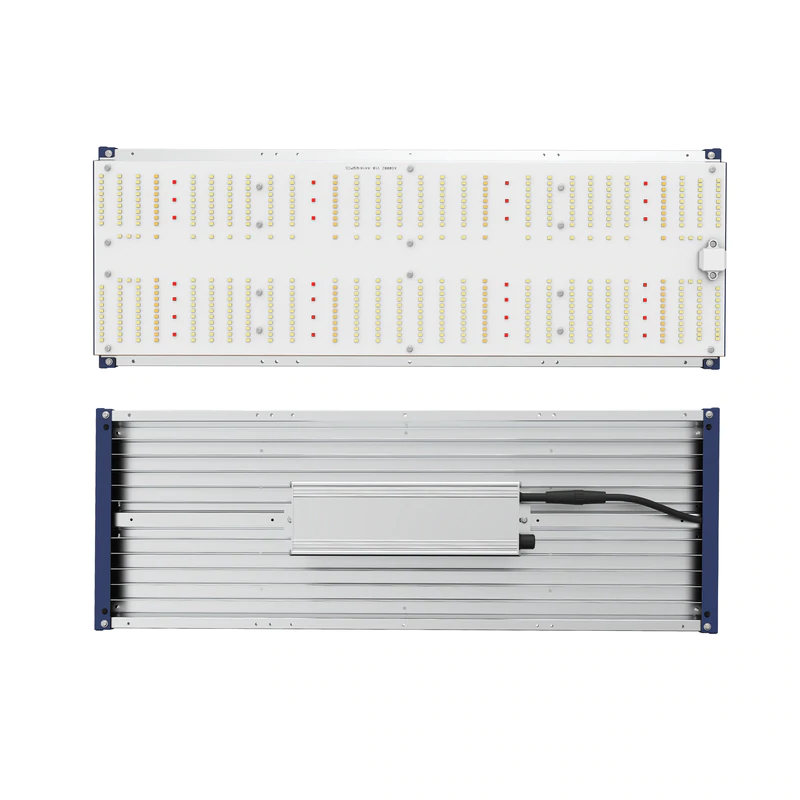
Features:
The ECO Farm LED grow light uses the latest high quality LED technology — Samsung LM301B diode, this energy-efficient LED increases crop yield and saves operating costs, produces more usable lighting per watt, and provides better light penetration. The spectrum of this grow light includes 3000K warm white, 5000K white and 660nm deep red, providing your plants with an excellent full spectrum LED grow light. Red and infrared light is especially useful during flowering, speeding up flowering time and increasing yields for ideal harvests. An additional dimming knob allows control of light intensity at will, giving plants the desired needs at all stages from vegetables to flowering. No fan, zero noise. Large area solid aluminium radiators help you achieve your ideal cooling system.
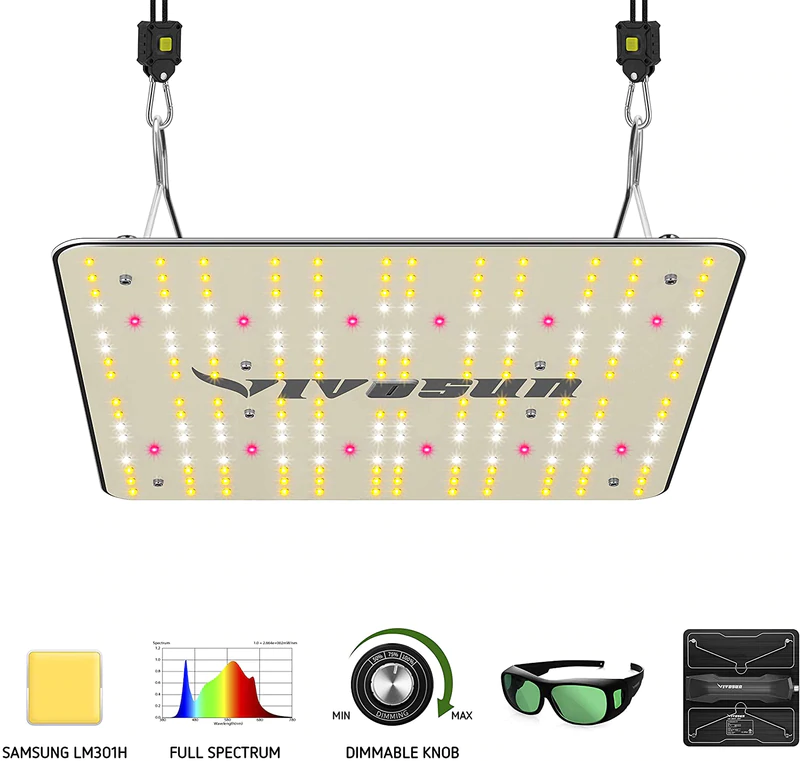
Features:
This LED grow light uses Samsung LM301H diodes, which are very durable. High energy efficiency of 2.75 μmol/J, lower cost and higher efficiency, consuming only 100W. More efficient than traditional HID lamps. Dimmable ballasts can adapt to the growing needs of plants at different times. The VS1000 Full Spectrum LED provides the best spectral coverage — more power for your flowers and maximum PAR output at all distances, plus super bright light your plants will love. The VS1000 eliminates the need for a grow light fan thanks to the unique exterior design of the power supply and vents. No fan means much lower noise.
Spider Farmer New SF1000D Series Full Spectrum 100W LED Grow Light
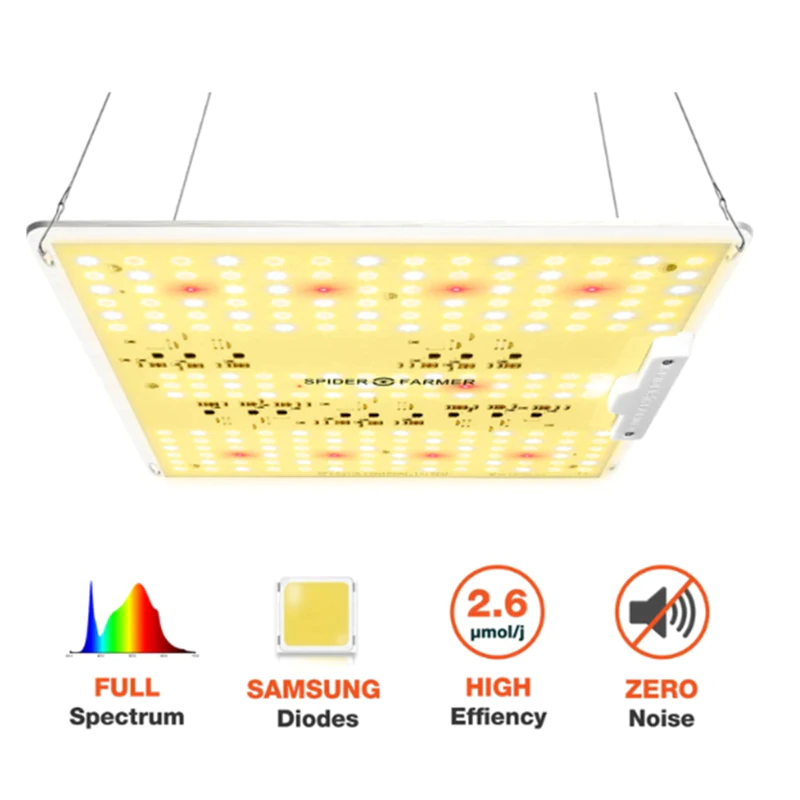
Features:
The SF1000D was changed from the SAMSUNG 301D diode to the more expensive 301B diode — the highest light output LED currently available, offering powerful light output and uniform canopy penetration compared to other LED grow lights to maximize yield. High energy efficiency, better light transmission. Consumes only 100W for better or comparable results than a 200W HID with 50% less heat and power consumption. Great for 3X3ft vegetables and 2x2ft flowers. Full spectrum 660–665nm, 3000K, 5000K and IR, ideal for all growth stages (germination, cloning or cuttings, mother, vegetative and flowering applications), turning your seeds into your own supply for beautiful high yielding plants.
How to Use Your LED Grow Light for Plants
You want your indoor plant to get the most out of growing light when you use it because this gives you the best chance of having a successful indoor crop all year round. If you have an HID light, you want to keep it at least 12 inches away, fluorescent lights should be as close as possible without burning them up to 12 inches, and an LED grow light can be six inches or more from your plant.
You typically put your grow light above your plants to encourage photosynthesis. As they start to sprout and grow, you’ll raise your light. Keep your light at the optimal distance depending on the style, strength, and whatever you want to grow.
Your plants need as close to the full light spectrum as possible because this mimics natural sunlight. You measure the different colors of the light spectrum by the temperatures they emit. High-quality LED grow lights and products emit more than one color, and they can cost more to do so.
Understanding what light spectrum your plants need will allow you to tailor your light choice to encourage the maximum growth throughout the year.
If you’re not sure what color your plants need to thrive, take a look at their specific needs. Tomatoes and other producing plants have more than one growth phase they cycle through. During the first stage, they leaf out and turn into more than a single plant. During this stage, they need more blue spectrum lighting because it’s warmer.
The second phase of the plant growth cycle starts when they begin to sprout flowers and reproduce. In order to help your plant reach this phase and cycle through it, your plant will need cooler temperatures like the yellow and red growth lights give. You want red lights for the growth stage as well
Conclusion
These LED grow lights are the perfect choice for any indoor grower looking to upgrade their indoor plant lighting. Grow lights are not only lightweight and easy to set up, but they also operate quietly. They are exceptionally bright and will flood your tent with effective PAR values for superior plant growth and higher yields.
2022 Best 600W LED Grow Lights for 4x4 Grow Tents
March 28, 2022
4×4 grow tents are perhaps the most popular-sized grow tents out there. They have a clear advantage over the other major sizes such as 2×2 and 6×6 or 8×8 because while 2×2 is too small, 6×6 and 8×8 are too large and will take up a lot of space inside a room. 4×4, on the other hand — hits just that sweet spot. In this article, however, we talk about a very special element that you need with your grow tent. We take a closer look at the best LED grow lights for 4×4 grow tents.
Why we thought it was necessary for us to write an article about these grow tents is that there are practically hundreds of options out there for LED lights of a tent this size. This is what we have gone through hundreds of grow lights to choose the best options for you! This is a definitive list of the top options that you have when it comes to buying a grow light for your 4×4 grow tent.
We have selected these grow lights on the basis of performance, price, and features. Our focus has also been on futureproofing our readers — so we’ve chosen most grow lights that follow the latest, most modern of standards, and can last you for years to come. A grow light is a long-term investment and is usually something that can last up to a decade if used with care.
Lastly, in addition to all this, we’ve also made it a point to not include any HPS/MH/Fluorescent light, and have gone only with LEDs, which offer the latest standards of lighting, are safer, consume less electricity, and operate at cooler temperatures. With that in mind, let us take a deep dive at all the best options available to you:
ECO Farm SP-600 Samsung Foldable Dimmable Full Spectrum LED Grow Light
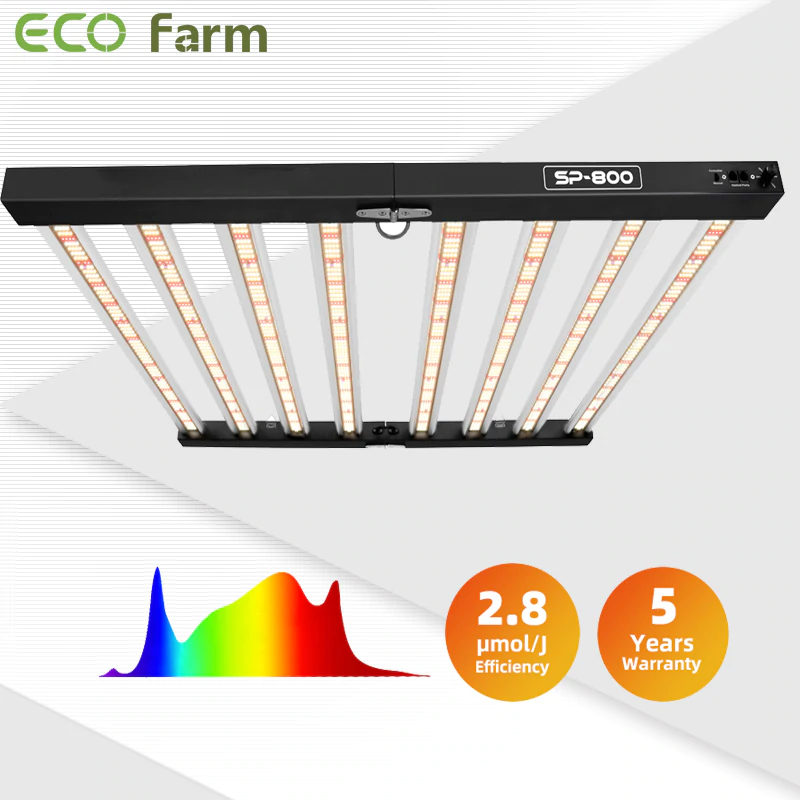
Features:
With a high efficiency of 2.8 umol/j and a power consumption of 630W, this ECO Farm LED grow light facilitates efficient growing operations, helping you efficiently optimize plant growth, improve yield quality and reduce operating costs. This full spectrum LED grow light promotes photosynthesis at all stages of growth, especially flowering, from cutting/seeding, nutrition and flowering. Grow lights for indoor plants replicate the spectrum of natural sunlight and output a broad, consistent and pronounced wavelength range from 400 to 700nm that can be grown throughout the plant life cycle. It can help your plants grow healthier and have better harvests. LEDs generate far less heat than HPS and other HID lights, making them ideal for gardening. The aluminum heatsink, along with the wide 6 passive cooling strips, better removes heat to keep you cool and reduces ambient heat in the grow space for longer lamp life.
BESTVA BAT W600 Dimmable LED Grow Light
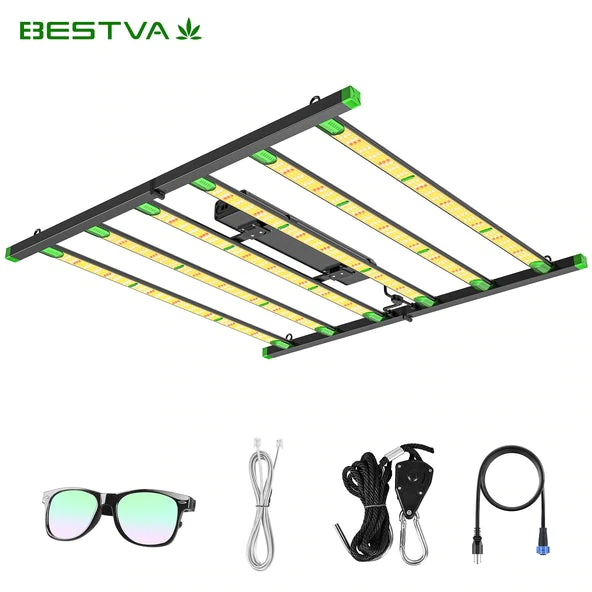
Features:
The BAT W600 LED is the solution for indoor growing environments where ceiling height and distance from the tree canopy are critical. The BAT W600 is ideal for use in vertical racks, low rooms, benches and even tents. The BESTVA BAT W600 provides an efficient full spectrum and a healthy red-blue ratio to drive photo composition. Light energy between 500–599nm, previously thought to be wasted, penetrates deep into the plant canopy and promotes photomorphogenetic responses. High color rendering “white” light helps quickly identify potential threats to crops and provides superior working conditions and safety for workers.
Grow Light Science PROGROW 640 LED Grow Light
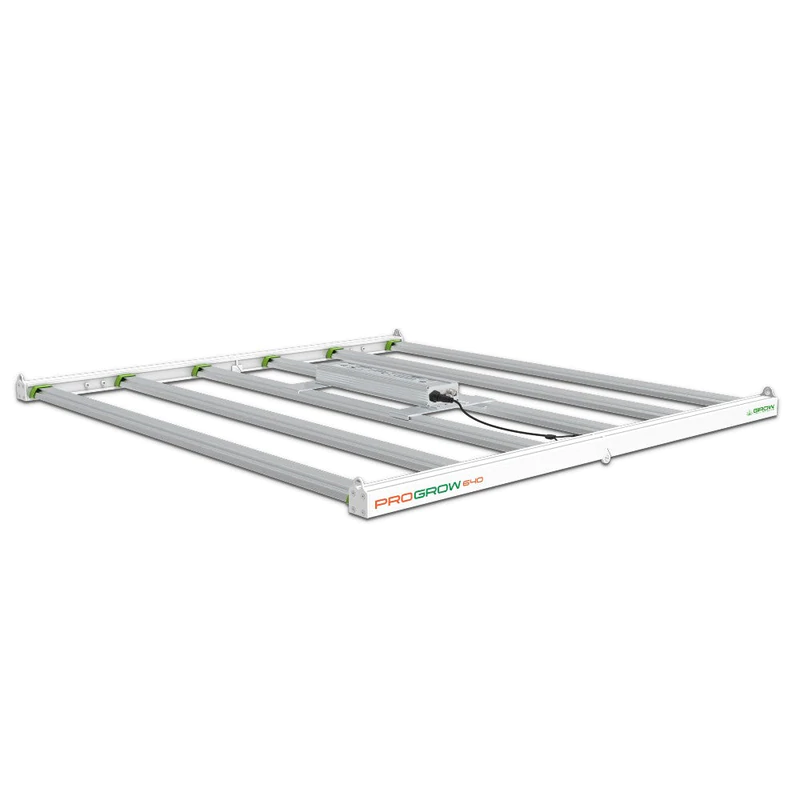
Features:
PROGROW 640 is a full cycle overhead lighting solution for commercial or residential plants cultivation. The 640’s form factor allows for expandability and multiple grow room and grow tent configurations where photosynthesis and yield maximization are the goals. PROGROW 640 provides high PPFD levels with or without CO2 supplementation. Top light output (PPF), spectral distribution and efficacy will deliver amazing results with little impact on your wallet. PROGROW 640 will deliver PPFD levels of over 1,000 umols/m2/s, either individually or in arrays of multiple cells. We recommend that all growers conduct research and trials within their growing space to design the best combination of inputs.
Best LED Grow Lights Buying Guide
Before buying the suitable LED grow light for your indoor garden, you must consider the following factors to get the ideal one:
1. Spectrum Type:
As we have mentioned above, different wavelengths of lights are responsible for the various growth stages of the plant. Depending upon the type of harvest you want to cultivate in your indoor garden, you should opt for specific grow light with a suitable wavelength.
Suppose you have multiple plants at different growth stages. In that case, it is advisable to go for an adjustable LED grow light that can tune to different wavelengths depending upon the plant requirement. So, always check the light spectrum and its wavelength range before buying the one for your plants.
2. Heat Output:
It is a crucial factor to consider while buying the top LED grow light for your indoor garden. Grow lights are generally mounted close to the plants, and thus, these LEDs mustn’t produce overheat as they can damage the plant’s growth.
LED with heat sinks or cooling fans are suitable for vertical gardens or indoor plants as they have no adverse effects on plants and can be placed even closer to them. An ideal Grow light must produce low heat to be the last longer, and you don’t have to replace it soon.
3. Grow Space Size vs. Light Coverage Area:
Depending upon the grow space size, you decide how many lights of how many watts will be sufficient enough for various plants’ growth. First, you should determine the size of the garden and then consider the area each light needs to illuminate.
Different plants require different voltage for their proper growth. For example, if you want to grow tomatoes, 32 watts of LED light per square foot will be suitable for it. But if you’re going to produce light harvests like Lettuce or anything, 11–18 watt per square foot is sufficient for that.
4. Efficiency:
The efficiency of the Grow Lights is one of the critical aspects you must check. An ideal grow light must be operated at a high level to produce high energy with a low maintenance cost.
So, before jumping to the suggestions of the best LED grow lights, you must consider all these aspects, make your calculation and then choose which one is ideal for you according to your requirements.
5. Real Wattage vs. Theoretical Wattage
Most of the LED lights have two wattages: Real Wattage and Theoretical Wattage displayed on their packaging. Theoretical Wattage is the potential wattage on which an LED light could run when LED chips run at full power. For example, A 1000W LED light can have theoretical wattage of around 600Watt. But LED lights never run on full power as it will shorten their life.
So, LED lights always run at 50–60% of their theoretical wattage, known as their real wattage. It is the amount of light LEDs actually consume to perform. So, a 1000W LED light generally has real wattage of around 300–400 Watt, and you must consider both these wattages before buying a grow light.
6. Cooling System
Large LED lights emit more heat while providing intense light to your plants for their growth, and thus they must be equipped with a proper heat sinking system and cooling fans for heat dissipation.
In the absence of both these things, the life span of LED light will shorten, and performance will decline. Also, the overheating won’t be good for your plants as well. So always give attention to the cooling system of LED grow light before buying one.
Why is the flowering coverage important while choosing a grow light?
When you are looking for a grow light, the only coverage number you need to consider is the flowering coverage. This is because vegetative coverage is usually larger than flowering because the height of the light is a little higher at that time. Basically, if you’re growing in a 4×4 area, and if your vegetative coverage is 4×4, then the flowering coverage is going to be 3×3 and some of your plants will be left out. This happens because the light is generally lowered and brought closer to the plants during the flowering phase. Hence, always make sure you’re buying the grow lights based on the flowering coverage and not the other number.
Conclusion
When it comes to LED grow lights, there are just way too many options in markets out there. With 4×4 grow tents being among the most popular size of grow tents, we thought it was important to put out a best-of list out there. We have tried to provide a review that is as detailed as possible, along with all the pros and cons of the products. However, if you think there’s a specific aspect that you want to know more about, or want us to review a grow light of your choice, do reach out to us over comments or on mail and we shall get it done as soon as we possibly can!
Top 3 Best 800W LED Grow Lights for Your Indoor Garden (2022 Updated)
March 05, 2022
When it comes to growing a productive indoor crop — the grow light of your choice will play a significant role. From lush, green foliar growth, rapid rooting, and a bountiful yield — grow lights play a key role during the entire indoor cultivation process.
What Type of Lighting Do Plants Need?
The first rule of indoor plant cultivation is that not all lighting is created equal. This means that, in the world of plants, they do prefer a specific range of light.
This range is known as photosynthetic active radiation (PAR) and describes wavelengths of light between 400–700 nanometers. For humans, the majority of light looks the same; however, plants experience PAR lighting in a very different way.
When exposed to usable light, such as the light in between 400–700nm, plants undergo photosynthesis, phototropism, and photoperiodism. These three functions are the reason why plants can grow leaves, turn towards the light, and eventually flower.
Therefore, when choosing the right grow light for your indoor grow — you’ll need to find a grow light with an optimized PAR range that caters to your plant’s needs. Let’s take a look at the two dominant color spectrums of light that are commonly used for growing plants indoors.
The White and Blue Spectrum of Light
As the spring comes to a close and summer begins, the sun reaches its apex in the sky. Not only are summer days long, but the light produced by the sun is also incredibly bright. When measured, this light falls under the white and blue spectrum of the PAR range.
Research shows that the bright light associated with the 400–470nm range (bluish-white) promotes strong vegetative growth and increased rooting. It’s for this reason that many indoor cultivators choose to use grow lights that produce light within the 400–470nm range while vegetating their indoor crop.
The Red and Orange Spectrum of Light
As the summer months wane and autumn sets in, the sun no longer reaches its apex in the sky. Instead, the sun begins to skirt across the horizon as the days become shorter — and colder.
The light that’s associated with the angle of the sun during this transition to shorter days is 620–700nm (orange-red). Research indicates that the red-orange color spectrum is a prime influencer for plants to begin the flowering process.
In regards to indoor plants, cultivators use this natural mechanism to their advantage. By harnessing photoperiodism, indoor growers use grow lights that produce light in the 620–700nm range to promote robust flowering.
ECO Farm G3 MARS 800W Samsung LM301B LED Grow Light
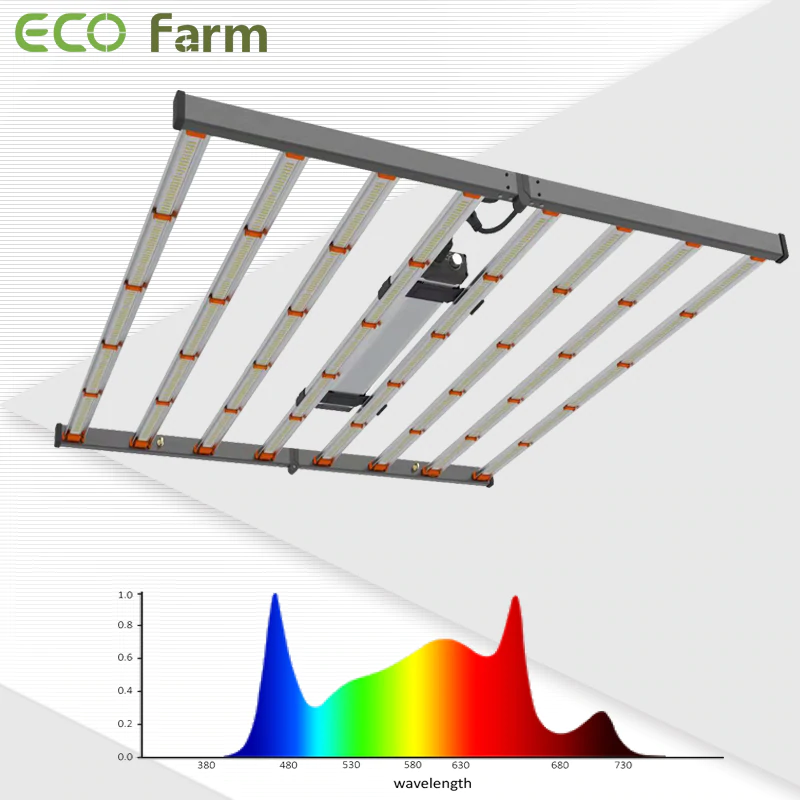
Features:
The ECO Farm LED grow light uses 2304 Samsung LM301B full spectrum lamp beads, 112 OSRAM 660nm and 32 730nm lamp beads, achieving the efficiency of 2.8 μmol/J. It is suitable for all stages of plant growth. It can speed up the flowering time and shorten the growth cycle. Growing area up to 5x5 feet. It has the best efficiency on the market. Increases plant yield by 50%. Removable light bars can be used to freely adjust the light density at different points within the effective coverage area, maximizing light utilization and creating an even crop. At the same time, it is easy to install, store and replace. Large aluminium cooling areas and passive cooling strips release less heat for better thermal management. IP65 waterproofing means you don’t have to worry about using the light in a damp room. In addition, it provides sufficient coverage for vegetation up to — 7x7 and flowering up to — 5x5, which further enables seeds to germinate quickly and transform plants in artificial sunlight.
MARS HYDRO FC-E8000 800W Commercial LED Grow Light
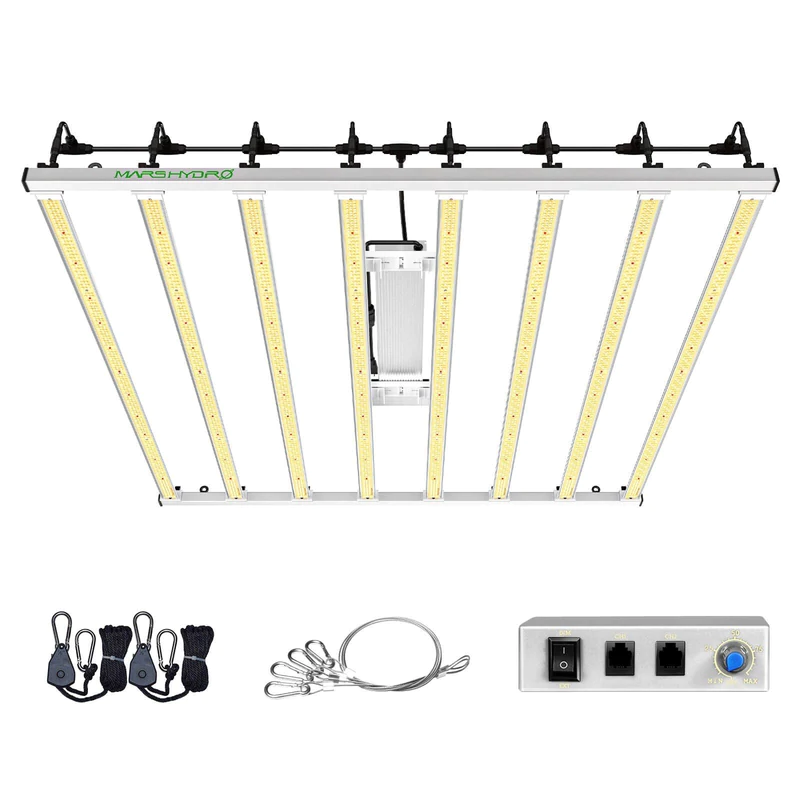
Features:
The Mars Hydro LED grow light is an affordable alternative lighting solution for commercial cultivation in supplemental CO2 applications, delivering a uniform PPFD of approximately 1500μmol/m²/s at 10" height. It is a standard commercially viable LED grow light for all indoor gardening looking to add extra CO2. The FC-E 8000 features 3,928 BridgeLux chips and a special chip arrangement for a more even distribution and an efficiency of 2.8 µmol/j that can take care of each plant and grow for optimum results. In a special combined spectrum, the FC-E 8000 is a full spectrum LED grow light that benefits the entire plant growth cycle, adding more red light to aid in flowering. Brightness can be adjusted from 0–100% to cope with different plant growth stages, dimming is more convenient and saves electricity bills. One master light can daisy-chain up to 30 lights.
Grow Light Science PROGROW 850 850W LED Grow Light
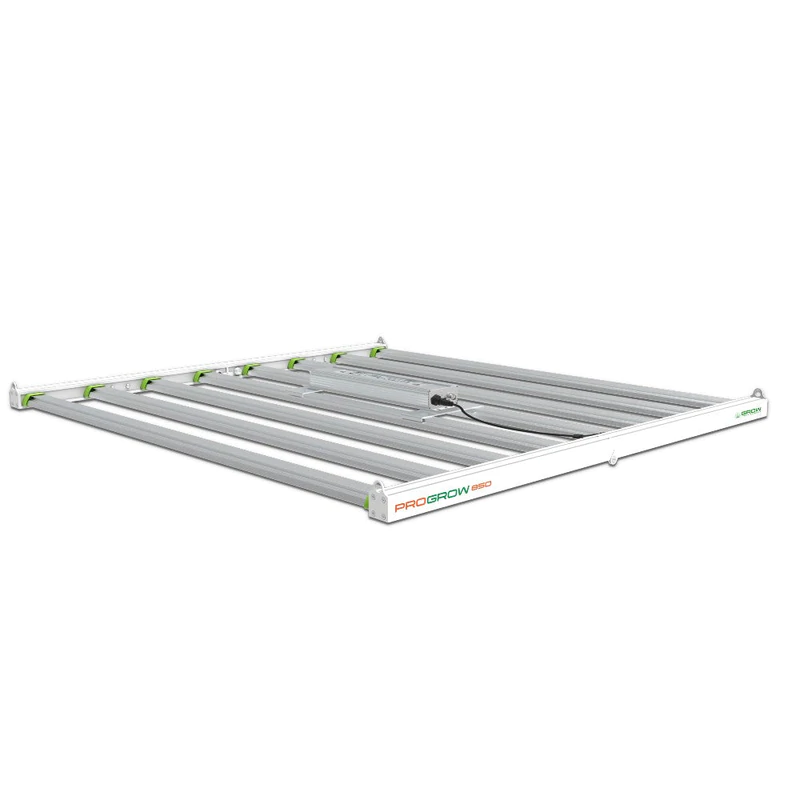
Features:
PROGROW 850 is a full-cycle overhead lighting solution for commercial or residential plants cultivation. The 850’s form factor allows for expandability and multiple grow room and grow tent configurations where photosynthesis and yield maximization are the goals. PROGROW 850 provides high PPFD levels and can be used with CO2 supplements. PROGROW 850 will also provide PPFD levels of over 1,400 umols/m2/s, either individually or in arrays of multiple cells. These top light output (PPF), spectral distribution and efficacy will deliver amazing results with a modest impact on your wallet.
What to Look for in a Good LED Grow Light Strips?
Why did I decide to talk about these LED grow light strips? Of course, there are many other great LED strip lights out there, but I wanted to share with you those that I’ve tried, so you know they’ve been tested.
If you prefer experimenting and trying some other brands, or if you’re unsure which of these eight models to choose, here’s an ultimate list of what to look for in a good strip grow light.
Have in mind the requirements of your plants and the space you have and choose wisely according to that.
Look for flexible ones
When wanting to purchase a strip grow light, you should look at those that can be easily placed to cover all your plants and provide an adequate amount of light from every angle, right?
That’s why the plant light you choose should be as flexible as possible so you can use it easily, even if you decide to change the place of your plants. Choose either those with the expandable design or LED strips that have gooseneck since those will be the easiest to adjust.
Installation
As you probably noticed in previous reviews, the majority of these models provide you with all the required parts for the installation.
This is very helpful since you’ll be able to install and use the strip grow lights as soon as they arrive. What’s also interesting to notice is that the smartest option when picking your grow lights is to buy those that can be installed in more than just one way.
Why is that important? Because in that way, you’ll be able to place the lights on various surfaces and change the place of installation multiple times if necessary.
No matter on which surface you need to install the lights, you’ll do it in quickly and effortlessly if you buy LED strips that come with double-sided adhesive tape, zip ties, and mounting screws, maybe even magnets — everything you need for an effortless installation.
Pick the right dimming levels
This is an important aspect for both regular and strip grow lights. The most desirable model will be the one that enables you to choose the brightness intensity and adjust it to your plants’ requirements during plant growth.
Many models offer five dimming modes that will make a perfect purchase for various kinds of plants as well as stages of germination. You’ll get to use the strip lights on multiple occasions and not solely for one plant.
Weight & support
Since full spectrum grow light strips are meant to be practical and useful, they should be light in order to be properly installed. You surely don’t want the danger of having the lights drop on your plants — choose the model that’s lightweight and be worry-free.
Timer is a great feature
If you’re away from home often, you’ll appreciate the practicality of having a full spectrum LED strip grow light that has the timer function included.
That will give you peace of mind when you’re not home because you’ll know that the timer will switch the grow light on and off automatically, depending on how you pre-set it.
Consider color spectrum
It’s always the best decision to choose strip grow lights that produce both blue and red light for your plants’ germination. Do your research and choose the best combo of red and blue light according to your plants’ requirements.
If you have more plants that demand different blue-red light ratio, buy full spectrum plant light that enables you to turn both colors on and off individually and create the combo you need. This way, you can provide both blue and red light.
Conclusion
LED Grow lights have come a long way in the last 5 years and there are some great new designs and changes that make these lights even more attractive to home gardeners. In this review, I believe that you have a look at some very important innovations and price changes of LED grow lights that make LED grow lights an even better choice. I wish this article will help you. Happy growing!
What Size Quantum Board LED Grow Light For 2×4 Grow Tents (2022 Updated)
March 01, 2022
Many peoples want to know about “what size led light for 2×4 grow tent”. If you have the same question so you are on the right way. We will tell you about it soon. But first, let’s say something about light for growing plants in general.
What Size Quantum Board Led Grow Light For 2×4 Grow Tent?
The size of the Led grow light depends upon the size of your grow tent. Also, the height of your plants and the number of reflective materials in the setup also matter. For example, with 6 plants in a grow tent, I would recommend a 400w Led light with a 50x50x6 inch reflective hood. 400w Led light can cover 6x2x4 feet grow tent. So the 2×4 grow tent is the minimum size grow tent that can be covered by 400w Led grow light.
How many plants grow in a 2×4 tent?
There are two ways to counter this. In the first calculation, we will use the standard industry definition “plant”. A plant is any mature vegetative organism that can be cloned from a single parent. Thus we need to figure out how many of these grow in a 2×4 tent. A 2×4 tent is a standard size for a small indoor grow operation. The term “2×4” refers to the size of the tent. 2 feet by 4 feet.
The width is 2 feet and the length is 4 feet. A “2×4” tent is a 1x3x3 grow tent. A 1x3x3 is a regular octagon shape. There are 8 sides so you can grow 8 plants in it. The second way of figuring this is to just consider it a standard 1x3x3 grow tent. In that case, you can grow 1 plant in it.
How much can you yield in a 2×4 tent?
If you plant your plants in pots and stake them up, you can yield 1.5 ounces per plant. If you plant them directly in the ground, you can yield 1.2 pounds per plant. The difference is that by planting the plants in pots, you have to harvest the buds and remove all the branches. But this method allows you to pick individual buds without damaging the plant. When you plant them directly on the ground, you can remove the whole plant and hang it upside down to dry.
ECO Farm LM301B UV&IR 450W Quantum Board
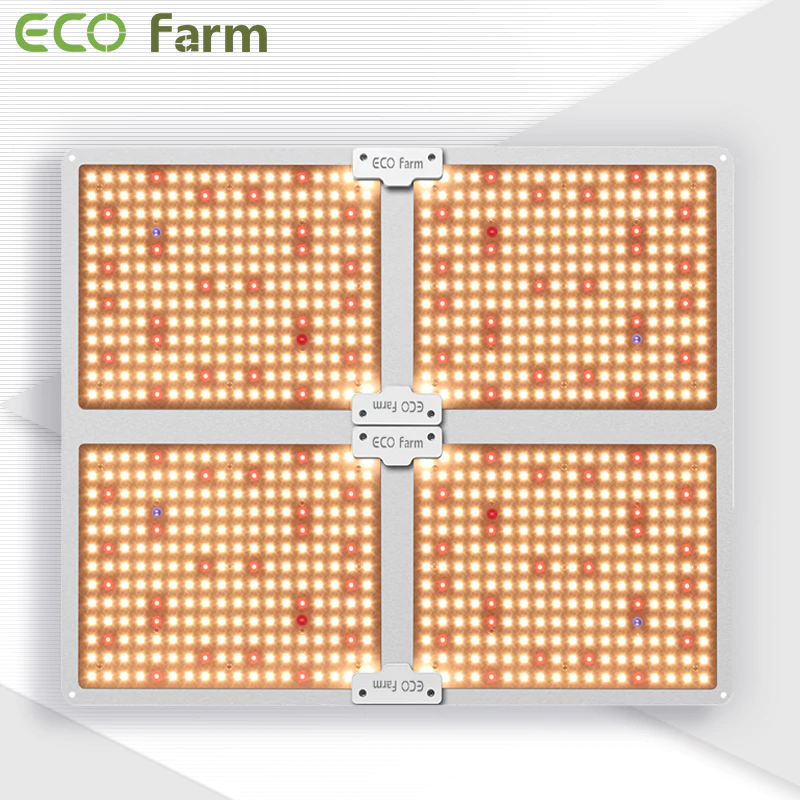
Features:
This ECO Farm LED Grow Light provides excellent lighting with even canopy penetration, significantly increasing planting numbers and increasing yields. The sunlike Full Spectrum consists of 660nm red light and 730nm far-red light, 3000K white light spectrum, adopts qualified Samsung LM301B diode, provides high PAR, light efficiency and light transmission, especially 660nm red light and 730nm light are very easy to use when flowering, It speeds up flowering time and increases yield, making it ideal for all stages of plant growth. This grow light features the latest high-yield LED technology, 2.7 umol/J, consumes only 450 watts, and a high-safety UL-listed driver for high PAR output and longer life to speed up the plant growth process and save on Increase yield while costing Save 50% on your energy bill compared to HID/MH/HPS lamps.
Bloom Plus BP 400W Full Spectrum LED Grow Light
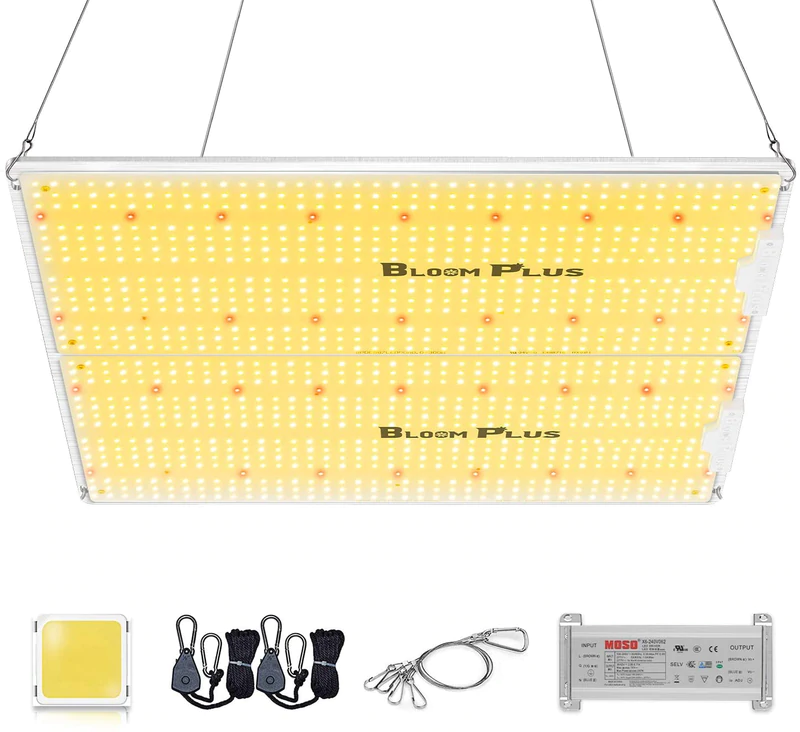
Features:
The BP4000 LED grow light achieves a high energy efficiency of 2.7 umol/J and improves light transmittance. LED grow lights consume only 400W of power, operating 50% less than other 800W HID/Blurple/HPS lights, while helping to achieve 50% higher yield harvesting. Full-spectrum LED grow lights provide everything your plants need in light at all stages. Designed for indoor growers, this LED grow light is designed to help individual indoor growers and greenhouse growers achieve higher yields and better quality on a budget. There is a dimmable driver on the back of the grow light, you can remove the rubber stopper and adjust it with a 3mm Phillips screwdriver (adjustment range: 1.5–3.0A).
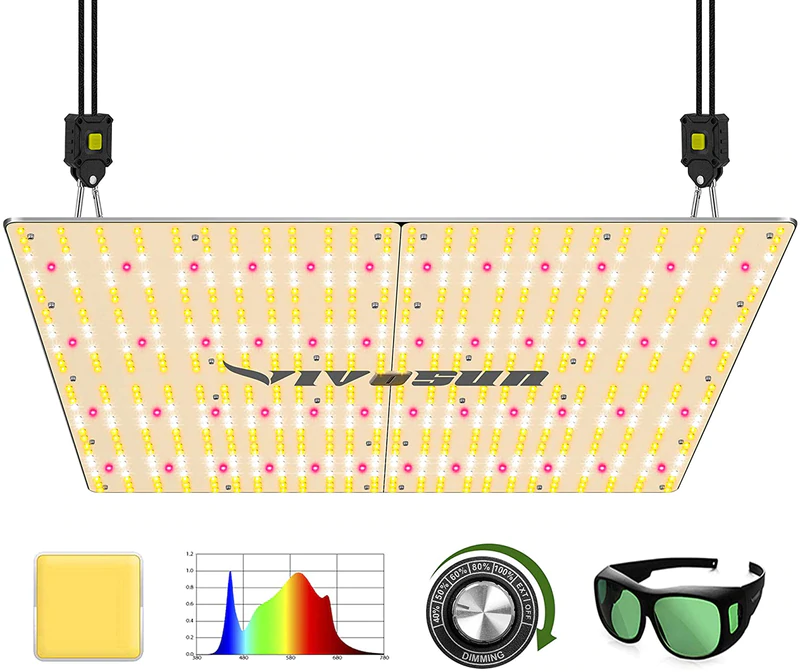
Features:
VIVOSUN’s VS4000 LED grow light adopts the latest LED grow light technology, with Samsung LM301H diode and brand driver, the energy efficiency is as high as 2.9μmol/J; extremely high output but only consumes 400W of power, making it more efficient than traditional HID lights and Other grow lights are more efficient. This LED grow light has a dimming knob and ballast, so it can be adapted to different plant growth stages by adjusting its output from 40% to 100%; super for beginners and professional growers alike Convenience. These Samsung VS4000 LEDs provide the best full-spectrum coverage and power plants need at all growth stages, with maximum PAR output at different distances, supporting efficient photosynthesis in indoor plants.
Buyers Guide
As more States have moved towards the legalization of plants led to increased indoor growing of plants. And in a bid to maximize yields, growers of plants have resorted to using kits as they consume less electricity, produce minimal heat and produce high plants yields.
In this regard, modern kits are years ahead of their predecessors that were rarely used in the indoor growing of plants. When buying led grow lights for your plants growing needs, there are a number of things you need to consider. Below are the main factors to consider in your search for the best LED grow lights for plants.
Price
As with any other appliance, price is an important factor to consider when choosing a panel for growing plants. However, it should never be the main factor that influences your decisions when selecting led grow light kits. The main reason why LED lights are in so much demand is they save on electricity costs and bulb replacement costs.
Contrastingly, if you have more plants to grow a $1000 led grow light will do a better job. A cheaper light will be incapable of providing light efficiently. To get a balance between price and performance go for a mid-range led grow light. These are lights that cost between $200 and $500. These lights offer more power compared to $100 grow lights but are less expensive than $1000 kits.
Warranty
Similar to any other product, the best led grow lights come with warranties. Some manufacturers offer a warranty of up to 3 years while others offer a limited warranty of 1 year.
When purchasing a led grow light be sure to check the warranty vis-a-vis what you are paying for it.
Construction
In every market, there are bound to be cheap knock offs and the led grow light market is no exception. Ordinarily, they are made using metallic components; however, there are a few cheap knockoffs that are constructed using plastic. Plastic is less durable compared to metal and thus plastic lights will have a shorter lifespan.
The most common metal used in the manufacture of best led grow lights are aluminum. The latter metallic material is a good conductor of heat and thus helps transfer any excess heat produced by the panel. This helps you minimize the amount of water you use on your plants.
The biggest problem with conventional HPS bulbs is that they emit up to 80% of their energy in form of heat. Therefore, when you are using these bulbs you will have to water your plants regularly. LEDs, on the other hand, convert a meager 15% of their energy to heat. Thus, the aluminum housing goes a long way in reducing the amount of heat produced by the light emitting diodes. If you stumble on a plastic panel do not buy it regardless of how cheap it is as it will be expensive in the long run.
One of the most important components of the best led grow lights are the drivers. There are two types of driver systems constant current and constant voltage. To ensure that your grow light is long lasting go with one that has the constant current driver.
The benefit of this driver system over the constant voltage system is that constant current keeps the current of the LED steady as temperature increases. The voltage tends to drop as temperatures increase. To counter this problem, it is wise to go for a constant current driver that maintains the LED’s steady voltage at all times.
Adjustable Spectrum
A full spectrum light will be ideal for all stages of a plant’s growth. Many of the mid to high-end panels reviewed have the ability to switch between vegetative and flowering stages with a flip of the switch.
This has two benefits, one being able to use less energy during the vegetative stage as plants doesn’t need as much light during this phase of growth. Second you will have the correct spectrum of light during the flowering stage to grow huge buds. Ideally, do some research into the different full spectrum led grow light brands available and choose the one you prefer.
Conclusion
There is no doubt that great satisfaction can be achieved by growing your own plants. For some people, indoor gardening is a fulfilling hobby, but for others, it is a serious enterprise that can significantly add to their income. No matter what is your motivation, there is a LED grow light setup that is perfect for your situation and budget.
Best 480W LED Grow Lights for 4x4 Grow Tents in 2022
February 25, 2022
By acquiring the best LED grow light for 4×4 grow tents, any crop will be much more efficient and productive. To this end, we analyzed the best tools for all the people interested.
This means that growing plants and flowers is now much easier. Even a grow light allows for great versatility in the location of a crop. Many plants and flowers will be able to be grown indoors in a home or commercial store.
What size LED light does a 4×4 cultivation require?
On the one hand, heat dissipation is one of the fundamental aspects depending on the number of plants or flowers in a given crop. Here it is necessary to take this aspect into account since an excessive amount of lighting could damage the plants considerably.
In turn, a grow cabinet with dimensions of 4 x 4 can offer between 500 and 1200 watts. Here it is also important to consider the type of plants or flowers. Different flowers and vegetables have varying requirements.
So the requirements of the different plants and flowers in a crop vary. This can certainly be very decisive when choosing the best LED light for 4×4 grow tent. Also, the most important thing is to avoid too little or too much lighting for the correct growth of the crop.
How to select the right LED for cultivating light?
Some factors are important in choosing the grow light that the plants need. In this case, it is a matter of taking into account the type of plants and flowers that are needed in a given crop. Some plants may need moderate lighting, while some flowers need a lot of light.
In particular, these aspects are critical because too much light can burn some plants, and too little light diminishes flower growth. So the spectrum and the amount of light produced by a grow lamp are critical aspects to consider.
Even the spectrum is the ability of a grow light to cover all stages of flowers and plants. Also, there are other basic aspects to consider, such as the installation procedure, a waterproof structure, and heat dissipation.
Although all these aspects are secondary, they are also important enough to develop cultivation with a good level of comfort. If energy efficiency is added to the above aspects, the user will be able to choose the best LED to grow light.
ECO Farm DBL5000 Full Spectrum LED Grow Light 480W
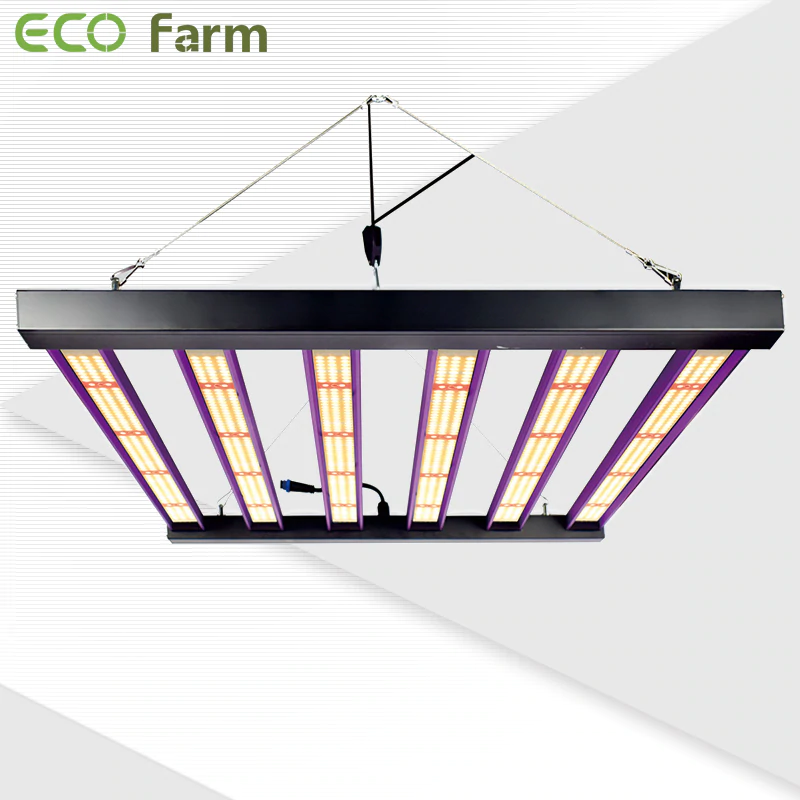
Features:
Compared to legacy lighting, ECO Farm LED grow light features a full spectrum light(3000K, 5000K, 660nm, 30nm) with high Photosynthetic Photon Flux(PPF), high energy efficiency (2.5µmol/J), offer light analogous to daylight necessary for plant growth. our commercial LED grow light will help to greatly reduce energy demands and increase crop yield. With this plant grow lamp, your plants can fast reach their full growth. The LED bar frame design, not only makes the led grow bar light easier to install, but also makes it has better performance in heat dissipation. The special diodes arrangement design can easily cover a plant space of 4x4FT only consumes 480w, making the luminous quantity and heat of the plant growth lamp more uniform, so as to avoid the excessive temperature to burn some plants, also avoid some plants by insufficient light.
Viparspectra KS5000 500W LED Grow Light
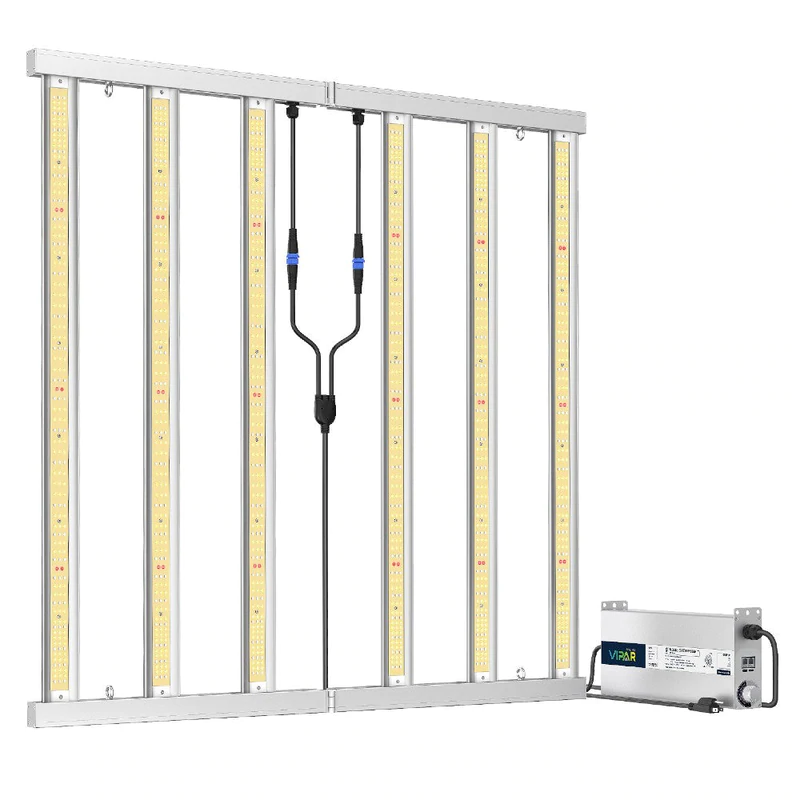
Features:
VIPARSPECTRA KS5000 LED Grow Light uses market-leading Samsung LM301H diodes (3.10 μmol/J) and Osram 660nm diodes, more energy-efficient LEDs that increase crop yields and save operating costs. High-end components give the KS5000 incredible performance. The KS series is designed for individual or commercial growers who want to optimize their growing space for maximum crop yield while producing the highest quality crops. The KS5000 Dimmable Grow Light with Daisy Chain allows you to connect up to 100 KS5000 grow lights to your commercial grow, horizontal and vertical farming, greenhouse growing, pipe grow, hydroponics, 4x4 grow tent. A built-in dimmer allows you to dial in the perfect PPFD for your plants at all growth stages. The KS5000 features a removable power supply that can be remotely mounted on the side of a rack or on an adjacent wall to remove heat from your grow space.
Mars Hydro FC-E 4800 480W LED Grow Light
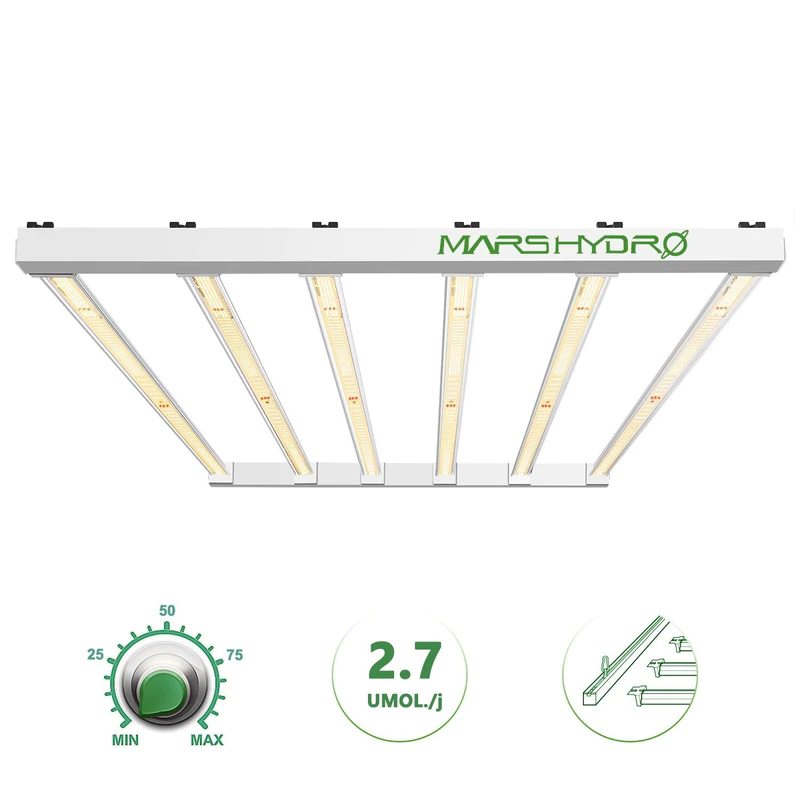
Features:
The MARS HYDRO FC-E4800 grow light features 2646 BridgeLux diodes, market-leading 2.8 µmol/J PPE, max 2.5g yield/watt, 480 watts in a smaller footprint, better crop quality and more cost-effective. 4x4ft for personal planting and 3x3ft for commercial planting. Built-in removable rod spacing and disabling allow precise dynamic PPFD control for each plant growth stage, the FC-E4800’s easy-to-install removable rods provide uniform, adjustable PPFD levels throughout the plant canopy, ideal for more uniform density buds. The detachable power supply can be remotely mounted on the side of a grow tent/shelf or on an adjacent wall to remove heat from the grow space; a true aluminium radiator and 6 ultra-thin passive cooling strips (thinner and larger surfaces ) produces less heat and lowers electricity bills by 50% than HID lights! With the Yield Max spectrum (660nm Osram Enhanced Deep Red, 2800k-5000knm, 730–740nm IR, 380–410nm UV LED), the innovatively designed FC-E4800 LED grow light is designed for commercial and home gardening.
Features and Benefits of LED Grow Lights
From professional gardeners to beginners, you can get huge benefits from grow lights.
You can use grow lights at all stages of your plantation (seeding, vegetables, flowers and fruits). Therefore, gardeners can use it for single or multiple purposes in the plantation.
If you see yellowish leaves and long branches, there may be a lack of light. You can use individual grow lights on that pot or throughout the garden.
In winter, grow lights can help keep your entire garden alive.
Grow lights allow you to start a garden in remote areas where sunlight is very scarce. You can even use these lights to grow a plant in your basement.
It helps keep plants healthy and free from disease. All fertilizers, water, and temperature are also important to having a disease-free garden.
Grow lights can increase the production of flowers, fruits and seeds in your garden. So, every time you harvest, you will reap the biggest harvest.
Grow lights or led grow lights are flexible in design and technology. You can use them as multi-level vertical systems, ceiling lights or lighting designs between plants. This type of lighting system is used in greenhouses and large indoor gardening. LED lights are best suited for this typical lighting system.
Another benefit of LED lights is that they produce less heat and provide better lighting performance. LED grow lights emit less heat than other lighting methods. Too much heat can damage plants, reducing growth and possibly causing plant death. LED lamps are more efficient in terms of low heat generation and bright lighting.
Unlike sunlight, it does not evaporate moisture from the soil. So you don’t need to water the plants much in one day.
4x4 Grow Tent LED Light Buyer’s Guide
When you are about to purchase a product what do you notice? price? I know the answer.
You set some criteria to define the quality of the product and after that, you check the price. However, here we are mentioning some criteria thus you can select the perfect one for yourself.
Check the Weight of the Product
Weight is a very crucial factor in this case. If you ignore it then your grow tent may fall for a small breeze. However, weight varies on the size of the grow tent. It’s better if you do not cross the limit of 30 pounds in the case of a 4×4 grow tent.
Check the Power Capacity
The wattage capacity is a vital factor here. If it’s not appropriate then you may not get the required spectrums for your plant.
Consider that plant you’re growing:
This is very crucial. Different plants have different requirements of the resources — heat, amount of light (lumen), the wavelength of light, etc. Thus, the first thing you need to consider when buying LED grow lights is what you want to grow under that.
Freedom of Adjustability:
I just told you that you should choose LED grow lights according to the plant you desire to grow. But is it going to be only one plant that you want to grow throughout your life?
No. Also, one particular plant might require a different set of mentioned resources throughout its life cycle.
That is why LED grow lights need to offer the freedom of adjustability. To which extent you can tweak the settings to meet the requirement of a wide range of plants — is something you should consider.
Consider the Heat:
LED grow lights produce good heat when they’re turned on. If you’re growing delicate plants, you should be aware of that. Excessive heat can cause the plants to be burned or scorched. When you’re growing delicate plants, it’s ideal to look for LEDs that produce less heat.
Electricity Consumption vs. Power Output:
Depending on the plants you’re growing, you may need to keep the LEDs turned on for about 10 to 11 hours per day, or even more in some cases. This will add up quite a number to your electricity bill, keep that in mind.
If you’ve got a reason to be worried about that, consider those LED grow lights that give good wattage output consuming less power. There are models that can do that.
How Many LED Watts Are Required Per Square Foot of Grow Space?
It could sometimes depend on the plant you’re growing in that space. But as a simple rule, you need to provide 30 to 40 watts per square foot of grow space.
What Features To Look For In LED Grow Lights?
Low Heat Output: Some cheap LED grow light tends to get overheat and make the environment hot. This could burn plants out. Also, LED grow lights that tend to overheat seem to have a shorter lifespan than the ones that don’t produce excessive heat.
Thus you save some money not having to buy LEDs again and installing them.
LED Grow Light With Cooler: Few LED lights have high-quality cooling fans included in them which internally cools the LEDs. This is great for lengthening the lifespan of the LEDs. Thus, you should look for LED grow lights with a high-quality internal cooling fan.
Quality of the Semiconductor Chip: It is like the heart of a LED grow light, and the heart needs to be of great quality, right? This chip is responsible for converting electricity into light and also determines the wavelength of light.
Make sure you buy a LED grow light with a good quality semiconductor chip that has a minimum wattage of 3.
Conclusion
We hope that the Top 3 best LED grow lights for 4×4 grow tents are helpful for both beginners and senior growers that want to replace the traditional grow light. For more information, please don’t hesitate to contact us. Thanks for reading and have a nice day.
Loriflux 4blade 180W LED Grow Light VS ChilLED Tech Growcraft X3 mini - 200W
February 21, 2022
When growing plants indoors — either commercially or just in an indoor garden or grow room — you need to have the right type of light to meet your growing needs. Regularly, growers decide between a few different lighting options, such as LEDs, fluorescent lights, metal halide options, or high-pressure sodium grow lights. Today we’ll be discussing LED grow lights for plants, which is a common question for growers. There are many options out there, and you’ll typically find some pretty conflicting information on which option is best.
In this article, we’re going through the definitions of LED bulbs, walking you through some of the best grow lights and then finishing off with our take on the best type of grow light for your needs.
Why Choose LED Grow Lights?
Everyone knows that LED consumes less power and produces far less heat than the popular and inexpensive HID or fluorescent lighting.
But the thing you don’t know is the plants respond to the LED in both the vegetative and bloom period. Yes, plants love LED grow lights and they grow faster with these lights!
You may read many LED grow light reviews, but this page is different!
Loriflux 4blade 180W LED Grow Light
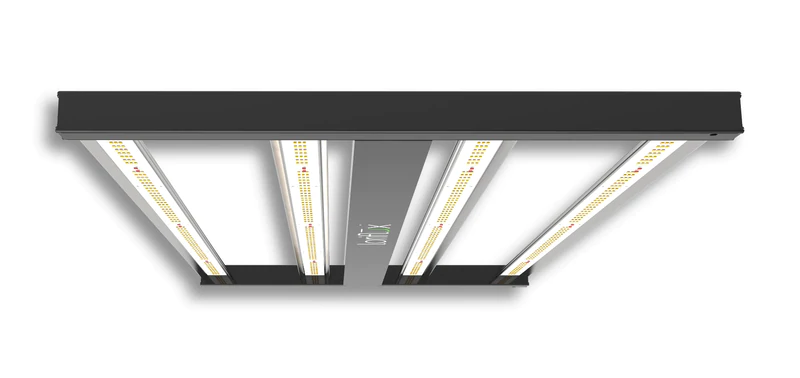
Features:
The Loriflux grow light is the perfect solution for early growth, be it cloning, culturing, nutrition, or even tent growing and flowering. The 4-Blade contains the same technology, features and benefits as our flagships, including Samsung and Osram diodes, built-in dimming and linking capabilities, and a 5-year warranty. The 180 W full-spectrum fixture with variable power levels will allow you to efficiently root clones, grow plant tissue, early vegetables, and even bloom in stealth growth or smaller tents and shelves.
ChilLED Tech Growcraft X3 mini — 200W
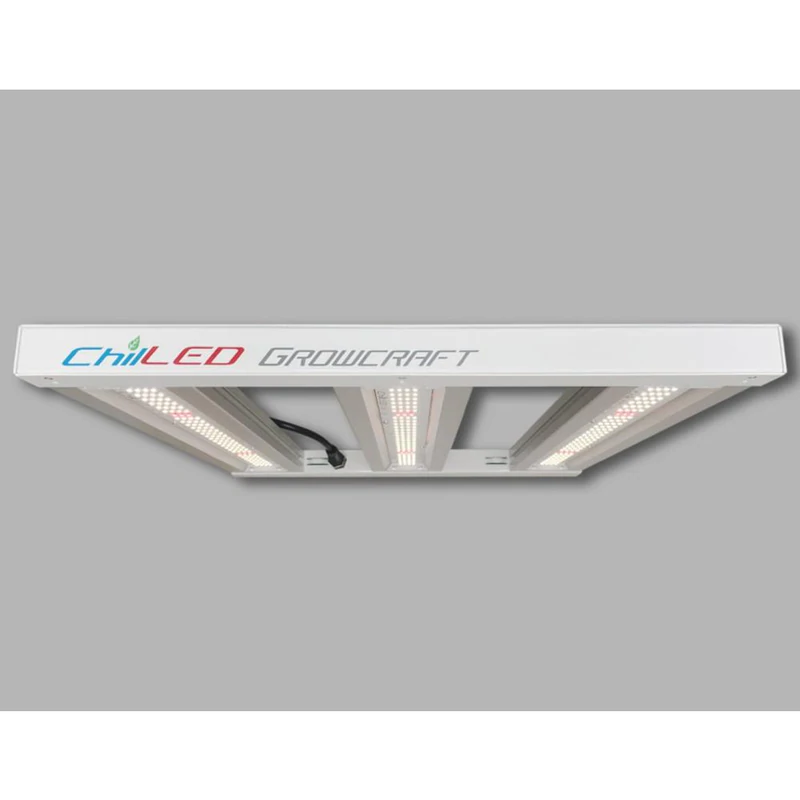
Features:
The ChilLED Grow Light is designed for serious growers with small growing spaces. Proudly made in the USA, these lights feature a slim construction requiring only 6 inches of headspace, while offering both 2x2 and 3x3 coverage areas. These lights have very high light output and can be hung from 6 to 24 inches above plants, so they are ideal for both beginner and experienced growers. ChilLED Commercial Grow Lights are constructed from extruded lightweight aluminium with a sturdy T-slot design and contain a mix of evergreen light panels and Samsung diodes for maximum blooming or plant growth.
Best LED Grow Lights — Buyer’s Guide
If you have decided on your LED grow light, here are a few pointers that you should not miss before making the final purchase:
Spacing
This is the first step. Take out your measuring tape as it is better to know accurate measurements than to buy a grow light on an estimated guess. As each light has a specific coverage area it can offer, hence, you need to know what can you fit within the space you have at home. Knowing your space measurements will also help you out in knowing the feedback from reviewers who had the same growth space as you.
Brand / Price
This will be critical as the grow lights offering better quality will generate maximum benefits. If you’re a learner, you’ll probably want to get your feet wet with a low-priced solution. If you’re skilled, you will know that with LED grow lights — good quality means more price. Knowing the product brand and their reliability is equally important. A popular brand with raving reviews is almost always — a safe bet.
Spectrum
A full spectrum LED grow light will help your plants grow to their maximum nutritional value. Depending on the stage of growth, you will need a red and blue spectrum, as well as infrared and ultraviolet lights. To ensure maximum growth, it is important to have a powerful light with different wavelengths.
The industry’s full spectrum yields are slightly newer, but they are quick to take their place in a grower’s catalogue. Full spectrum grow lights run cool and need no extra fans. They save on energy and cost less overtime. Most LED lights have a variety of colors emitted — including the best LED grow lights that have a full range of IV/UR rays.
Electrical Usage
As they use a lot of electricity, it is wise to get a grow light that cuts down on the electricity bills. An average LED grow light operates for around 10 to 12 hours a day. The higher light intensity you choose (1000w, 400w, 300w etc), the lesser electrical usage takes place in the most cost-effective ways.
Light Control
Depending on the stage, you’ll want to ensure that your plants receive the proper amount of lighting (down to the exact hour). It’s extremely important that light cycles are followed to a tee as it can severely alter the growth and potency of your plants.
Conclusion
To sum things up, the best-LED light doesn’t come easy. You will have to go through quite a lot of considerations to make sure you are getting the best thing for your setup. Not every option will be suitable for everyone, so you must choose based on your preferences.
Marijuana Grow Lights for your Commercial Greenhouse 2021 Buyer’s Guide
June 03, 2021
Commercial Greenhouse Grow Lights
Horticultural lighting poses unique problems. Many commercial greenhouse grow lights are installed using LED lighting or Sodium Lights (High Pressure Sodium Grow Lights — HPS). Which one is a better solution is a common question. LED grow lights are rather new to the horticultural lighting world, where HPS grow lights have been around for quite some time. There are grow forums around the world who can debate a pro and con list that will equal at any length. So often times, commercial greenhouse grow lights are chosen based on past experience. The horticultural lighting migration from incandescent to fluorescent to high intensity discharge (HID) halogen, to high-pressure sodium (HPS) to LED has taken time; however, renewed interest in energy conservation and novel production is fueling a rapid growth in LED technology.
Commercial Greenhouse HID Grow Lights
HPS grow lights produce a massive amount of raw light output. That is the key to their popularity. This intensity can produce great crop yields which is ideal when working with very large plants. But this lighting intensity also has the downside of using more electricity, generates more heat which increases costs for maintaining grow room temperatures with the necessity for added ventilation, and HPS grow bulbs often need replacement every 12–18 months. All of this adds to higher operation costs using HPS as your horticultural lighting solution.
HPS (High Pressure Sodium) lighting is the most popularly used light source with a proven track record for cannabis growers, providing bright, intense light with a reasonably long lifespan.
- Provides a wide spectrum of light colors
- Fairly efficient and less costly when comparing output per wattage
- Smaller in size than LPS or fluorescent lights
- Cheaper alternative to other options on the market
- Provides extra heat which is very beneficial to the marijuana plants in the winter
- GGS can help with supplemental cannabis greenhouse lighting and with primary lighting for indoor marijuana grows
Commercial Greenhouse LED Grow Lights
LED grow lights are without question the most efficient lighting type available resulting in huge savings on your power bill. LED grow lights emit very little heat which makes them ideal for indoor growers especially those using vertical farming methods. LED fixtures are manufactured as a single encased fixture which makes them easy to handle and reduces their size making them ideal for tight spaces. LED fixtures run higher in price than HPS grow lights, but their reduced operating costs pay back in dividends. Colder climate greenhouses and grow rooms using LED horticultural lighting may need to supplement the heat source of your indoor area to help maintain desired growing temperatures.
Cannabis growers are taking advantage of the energy savings that LED marijuana grow lights can provide.
- Can cut energy use in your cannabis grow facility by up to 75%
- Yield benefits can offer far beyond kWh savings
- Provides the wavelengths and intensity you need with adjustable-spectra LEDs
- Lower maintenance and reduced maintenance costs as diodes last much longer than conventional bulbs
- Flexible light adjustment; they can be dimmable or can be turned onto full instantly
- Available in a variety of temperatures for color accuracy
- Fixtures can be placed closer to marijuana plants for greater efficiency
- Multiple level cannabis growing is possible
- Reduced wire size and associated wire costs
3 Best Commercial Grow Lights
Black Dog LED PhytoMAX-2 600 Grow Lights — Best Canopy Penetration LED Grow Light for Indoor Plants
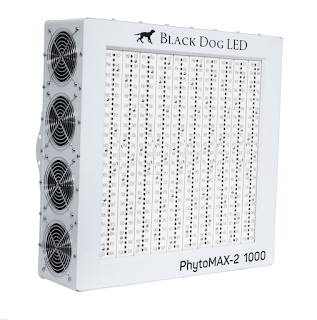
Black Dog is known for producing the powerful and compact LEDs with the large footprints that are ideal for commercial cannabis growing. The models from PhytoMAX-2 line stand out as highest rated, latest-technology LED grow lights.
These large scale LED grow lights provide high energy spectrum and light intensity, which is essential for canopy penetration. That way they nourish flowers and leaves of cannabis plants, encouraging them to produce a higher yield with high-quality flowers as well as more trichomes. To improve efficiency, the housings are created for maximum heat dissipation and light distribution.
At about 3 dollars per Actual Watt, the Black Dog lights can compete with the top-end lines. Commercial growers like them because of their great spectrums — ultraviolet and infrared. Also, they offer a large coverage area of 25 square feet (5′ x 5′) in bloom and 6.5′ x 6.5′ in the vegetative stage for marijuana plants.
Pros:
Large footprint coverage
15 LED color ranges
Unprecedented canopy penetration
Exceptional heat management
Powerful
Compact
Cons:
Uses full power all the while
Pricey
ECO Farm Z6-600 Ultra Samsung LM301B LED Grow Light With Separately UV+IR Control

Removable and Replacable Lightbars ,dimmer Control on every driver ;
IR is independently controlled,UV is independently controlled;
Samsung LM301B Full Spectrum White Light Diodes, 660nm Red Diodes, IR+UV Diodes on independent controls.Each LightBar is Made up of 272 pcs leds: Totaling 1,632 diodes per light ;
4x4 - 5x5 flowering footprint;
Maximize Every Inch of your Garden with The Best Distribution of Light on the Market with Over 1000 PPFD Corner to Corner;
ECO FarmPassive Cooling design easily allows air flow between lights, Extended Driver cables allow for Remote Mounting of the driver away from you plants, Making heat management an actual breeze;
DESCRIPTION:
| Model | Z6-600 Ultra |
| Spectrum | Samsung LM301b 3500k + 660nm Far Red + IR + UV |
| PPF | 1752.6μmol/s |
| Efficacy | 2.9 μmol/J |
| Flux | 104611LM |
| Input Power | 600W |
| Input Voltage | 100-277V |
| Power Factor | >0.95 |
| Dimming | 0-10V |
| Light Distribution | 120° |
| Working temperature | -20℃-55℃ |
| Lifespan >50000hrs | >50000 hour |
| Dimensions /(mm) | 1000*1000*113 |
| Packing size /(mm) | 1150*210*270 |
| N.W|G.W /(kg) | 11.55/13.6 |
| Certifications | CE、Rhos、Fcc |
| Warranty | 3 years |
| Diodes | SAMSUNG 301B 3500K/1512PCS OSRAM 660nm/72PCS OSRAM 730nm/24PCS SEOUL 395nm/24PCS Inventronics Driver 6 Bars 100W/Bar UV/IR Switch Buttons Separate Control |
California Lightworks Solar System LED Grow Light — Largest Vegetation Footprint Coverage

The SolarSystem is an advanced, powerful, latest-generation LED lamp from California Light Works. It’s suited for both vegetative and flowering stages thanks to a programmable light spectrum control that allows for effortless indoor growing. That means you will have control over all lights throughout all phases of growth for the best results.
There are three models to choose from: SS275, SS550, and SS1100. The first option is not favorable for commercial growing, either. If you go with the mid-size 400W SolarSystem 550, you’ll get a lightweight yet compact profile that can last for 50,000 hours and replaces a 600-Watt HPS system. The top-of-the-line SS 1100 light features 800-Watt actual draw and low heat output. Aside from the lighting system itself, you get a built-in timer, ratchet ropes, and networked control all in one package.
Even though this light comes with a high price tag, it will save you money in the long by reducing energy consumption costs every month. You can significantly cut down your energy bills by linking a few SolarSystem LED lights together. That will do the trick!
Pros:
- Programmable spectrum control
- Impressive vegetation footprint
- Low operating temperature
- Perfect LED grow light for veg and flower alike
- Method Seven LED Glasses
- Comes with a built-in timer
Cons:
- Flowering footprint could be better
- Costly
FLUENCE SPYDR VS GAVITA PRO LED GROW LIGHT
June 02, 2021
FLUENCE SPYDR 2P LED GROW LIGHT SYSTEM
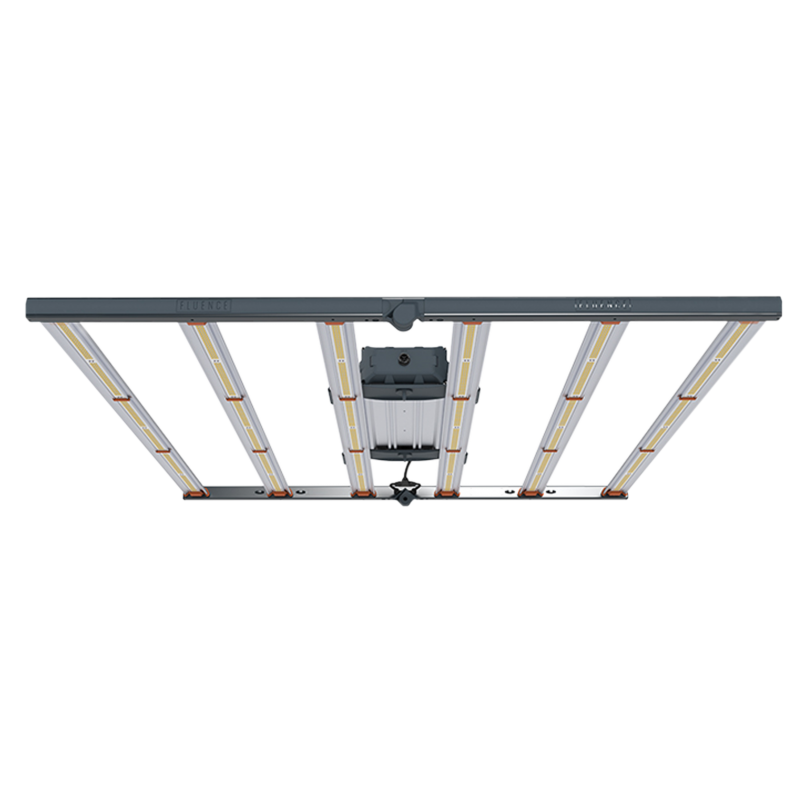
The Fluence SPYDR 2p is an improved, more powerful version of the SPYDR Plus. Just like the 2i, the SPYDR 2p is developed for High PPFD Cultivation, which makes the grow light in principle suited for growrooms in which extra CO2 is added to the air. A boosted quantity of CO2 of 800 to 1,400 PPM (normally this is 400 PPM, 0.04%), in other words, a percentage of 0.08 to 0.14%, will enable a plant to safely transform that huge light intensity into carbohydrates and energy. The beneficial effect for the grower is that, due to this, the life cycle of his plants is significantly accelerated and, additionally the yield is increased up to 20%. I.e.: High PPFD Cultivation will generate more crop in less time.
The SPYDR 2p resembles the 2i in many aspects, but the most important difference is the light intensity. The 2p is less powerful which makes this LED nursery lamp in principle also suited for growers that work without CO2. It is important however, to keep a minimum of 40 centimetres between lamp and plant. At a shorter distance, the light intensity will damage the plants.
The Fluence SPYDR 2p is fitted with a PhysioSpec Indoor spectrum, developed by Fluence themselves. This is a tailor-made spectrum for the indoor grower and intended for the entire life cycle of your plants. So, also seedlings, shoots and clones will feel very comfortable in the light of this lamp. The PhysioSpec Indoor spectrum scores 85 on the CRI-scale, meaning that the radiated light is excellently suitable for the work and research conditions in which natural, lively colours and proper contrast are essential. The Fluence SPYDR 2i does not include a built-in dimmer. This can be obtained separately only. One dimmer can be connected up to 50 SPYDR 2s.
The Fluence SPYDR 2p is a professional LED grow light, highly efficient in energy consumption. Thanks to the large light surface, the light is distributed quite evenly across the growth surface and will have no trouble penetrating the foliage. The materials used by Fluence, the straightforward design and the lack of fans make the Fluence SPYDR 2i a soundless, solid grow light that will last for many years, hassle-free. The Fluence SPYDR 2p can be connected to the mains electricity as stand-alone or in daisy-chain. This LED grow light is suitable for use in racking (vertical farming), cultivation tables and in grow tents. A hanging fixture is included.
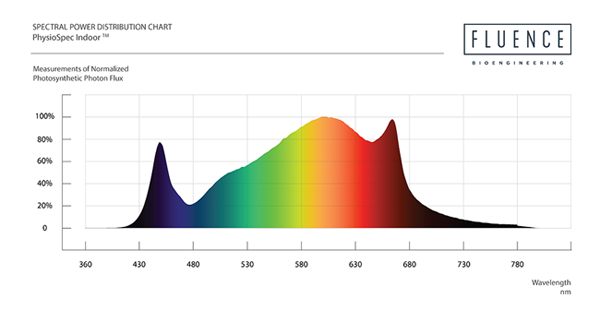
High PPDF-growing with CO2 requires knowledge of photosynthesis and the effect of CO2 on your plants. It is important to realise that in case of too little CO2 in the air, the bright light cannot be transformed into energy and carbohydrates, as a result of which your plants may get damaged. On the other hand, the additional CO2 in the growing area will only be transformed in case there is sufficient light intensity. Using the powerful Fluence SPYDR 2p that is one thing you needn’t worry about.
Gavita Pro 1700e LED Grow Light
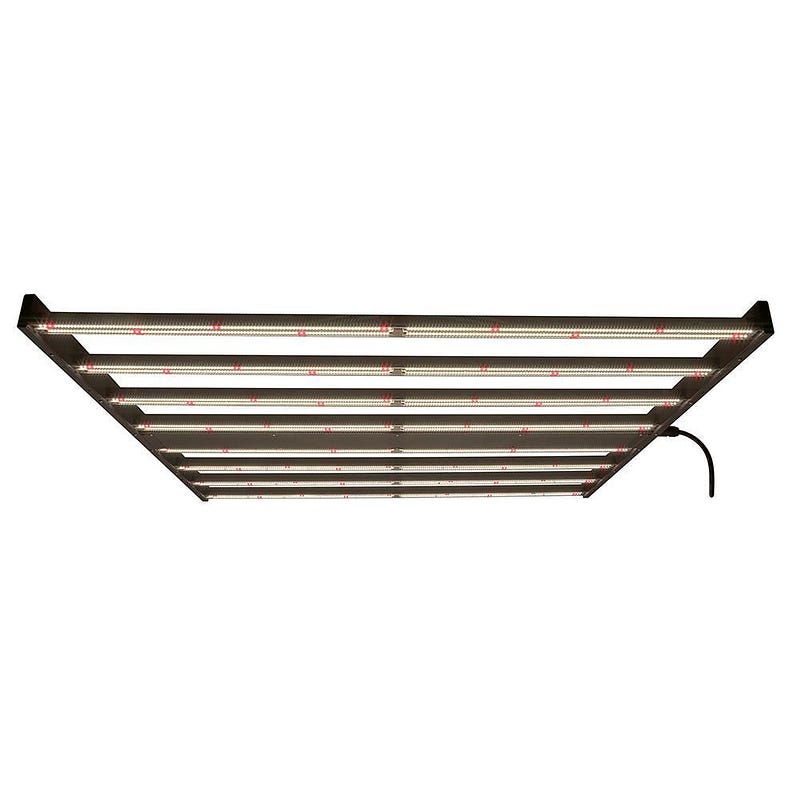
The Gavita Pro 1700e LED fixture operates at 645 watts with an output of 1700 µmol s-1 PAR and an impressive efficacy of 2.6 µmol s-1 per watt. The Pro 1700e delivers broad, intense light coverage with its 8 passively cooled LED bars allowing you to use it in low rooms, vertical racks, over benches, or even in tents. This powerful, full-spectrum light source is intended for full-term plant growth from the vegetative stage to the higher-light-requiring bloom and finishing stages. Built with premium Philips drivers, Samsung white LEDs and Osram deep-red LEDs, this fixture uses only the highest-quality components. The fixture is dimmable to 50% without any loss of efficiency using the Gavita E-Series LED Adapter and Gavita Master Controllers. The Gavita E-Series LED Adapter — 120–277 V (#906151, sold separately) is required for each fixture when using the controller; non-controlled fixtures simply operate at 100%. The Gavita Pro 1700e LED fixture and Gavita E-Series LED Adapter are FCC compliant, UL1598, and IP66 rated for use in wet environments with a maximum ambient operating temperature of 40°C. Sun Grip® light hangers included.
- 8 passively cooled bars eliminate moving parts and provide full-spectrum, broad-coverage light for full-term growth
- High-output 1700 µmol s-1 PAR and an impressive efficacy of 2.6 µmol s-1 per watt
- Dimmable to 50% when using the Gavita Master Controller and E-Series Adapter
- FCC compliant, UL1598 and IP66 wet-rated for use in wet environments, allowing for versatile placement in growing spaces with low ceilings, vertical racks, benches or even in tents
- Reliably sourced components including Philips Drivers, Samsung white LEDs and Osram deep-red LEDs make the 1700e built to last
- Sun Grip® light hangers included for quick, easy installation
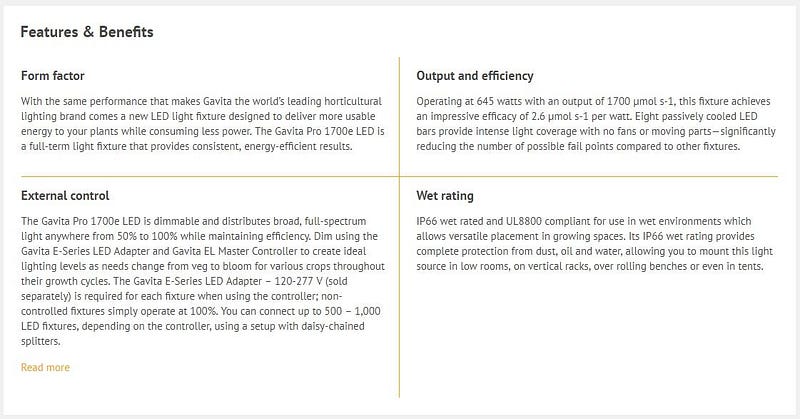
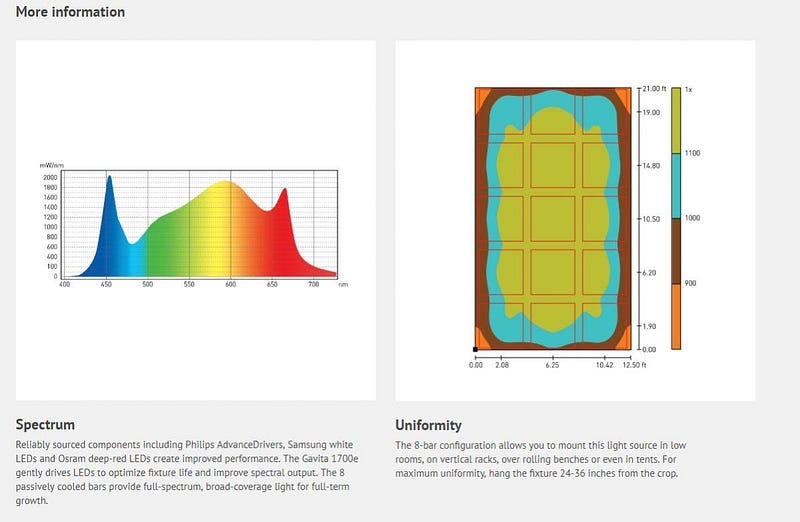
Iluminar iL9x 1000W LED Grow Light VS ECO Farm ECOM 1000W LM301B Full spectrum LED Grow Light Bars
May 15, 2021
How much area are you looking to light?
The best place to start is to figure out the square footage of the area you are trying to light. For high-light plants like tomatoes you will want to achieve around 40 watts per square foot for optimal growth and fruit production. For low light plants, and small leafy plants like herbs and lettuce, you will only need to achieve about 25 to 30 watts per square foot. When figuring your area don't necessarily go by the actual size of the room. You will want to measure only the plant area that you will be growing in. In other words, if the grow room is 5 x 5, but you will only be growing in a 3 x 3 area there is no reason to get a light big enough for the whole room. Using that as an example, you have a 5x 5 growing area so you must figure out how many watts you will require to light that area. We will be growing tomatoes so we will want to achieve 40 watts per square foot.
Width x Depth = Square Feet, e.g. 5 x5= 25 sq. ft.
Watts x Square Feet = Desired Wattage, e.g. 40 x25 = 1000 watts
We will just round the 900 watts up to 10000 watts. So, we know that we will be in the market for a 1000 watt LED grow light...
Iluminar iL9x 1000W LED Grow Light

The center Power Hub allows for hard mounting the LED bars to the Hub or remote mounting during multi-level grow environments when every inch counts.
The iL9x 1000W from ILUMINAR has a tuned Full Spectrum array and engineered for vegetative and flower cycles that require high μmol performance at a lower clearance to the canopy.
The iL9x 1000W LED is a full spectrum array designed for veg and flower cycles that require a high μmol performance at a lower clearance. Ideal for many settings from commercial facilities to hobby gardeners. Enjoy the flexibility of hard mounting the LED bars to the center mast or remote mounting the bars directly to the rack for multi-level grow environments where every inch matters.
The iL9x is now available in a higher efficacy giving the grower higher µmol per Joule output for the same wattage used. The ILUMINAR iL9x 1000W LED fixture delivers more when you need it most.
The iL9x comes in either 120-277 Volt or 200-480 Volt.

IL9X TECHNICAL SPECS
- PPF: 2600 µmol/s
- Efficacy: 2.6 µmol/j
- Input Power: 1000W
-
Emitter Type: Osram SMD LED Diodes
-
Input Power: Smart Sensing™ 120V to 277V & 347 to 480V
-
Mounting Height: 6”-12” to top of Canopy
-
Emitter Cooling: Passive / Extruded Case
-
Dimming / Controllable: 0-10V Controllable
-
Light Distribution +/- 5%: 125º
-
Waterproof Rating: IP65 for Damp/Wet Conditions
-
LED Lifespan (90% of Life): 55,000+ Hours
-
Power Factor: > 90%
PHYSICAL SPECS
-
Height: 5 in / 129mm
-
Width: 39.5 in / 1003 mm
-
Length: 42in / 1067 mm
-
Weight: 40.96 lbs | 18.58 kg
ECO Farm ECOM 1000W LM301B Full spectrum LED Grow Light Bars

ABSOLUTELY LARGE COVERAGE -- ECOM 1000W With total 2400pcs LED chips, this 8-bar LED grow light offer a extremely large irradiation area for plenty of plants. Coverage 6x6ft for veg, 5x5ft for bloom. Lightweight aluminum alloy material, detachable light bar and daisy chain design. Perfect for indoor, greenhouse planting, personal and commercial growth. Use only one light for 4'x4', 5'x5' or 6'x6' tent.
DIMMABLE AND DAISY-CHAIN FUNCTION-- Design for full plant life cycle. The light intensity can be adjusted by knob. With daisy-chain design, one light can control the intensity of the other 10 lights by dimmer at the same time.. The plant growing light includes 1536 pcs LM301B 3000K leds, 768 pcs LM301B 6500K leds, 96 pcs OSRAM 660nm deep red leds..
HIGH EFFICIENCY Samsung LEDs -- The Samsung LM301B chip LEDs used in this LED grow light are professionally customized and produced with the latest technology. Higher light intensity, lower speed of light decay and higher PAR values than ordinary lamp beads. It provides 2.5 μmol/J high efficacy .Maximize yield and optimal quality.
LOW HEAT AND NOISE FREE-- Saving up to 50% energy and 30% cooler than other grow lamp. Consuming only 650W with 2400 LEDS! The latest aluminum radiator has special surface treatment that doubles the heat dissipation area. IP65 Waterproof. High power, low heat and low failure rate grow lamp. No fan, no noise.
ECOM1000W PPFD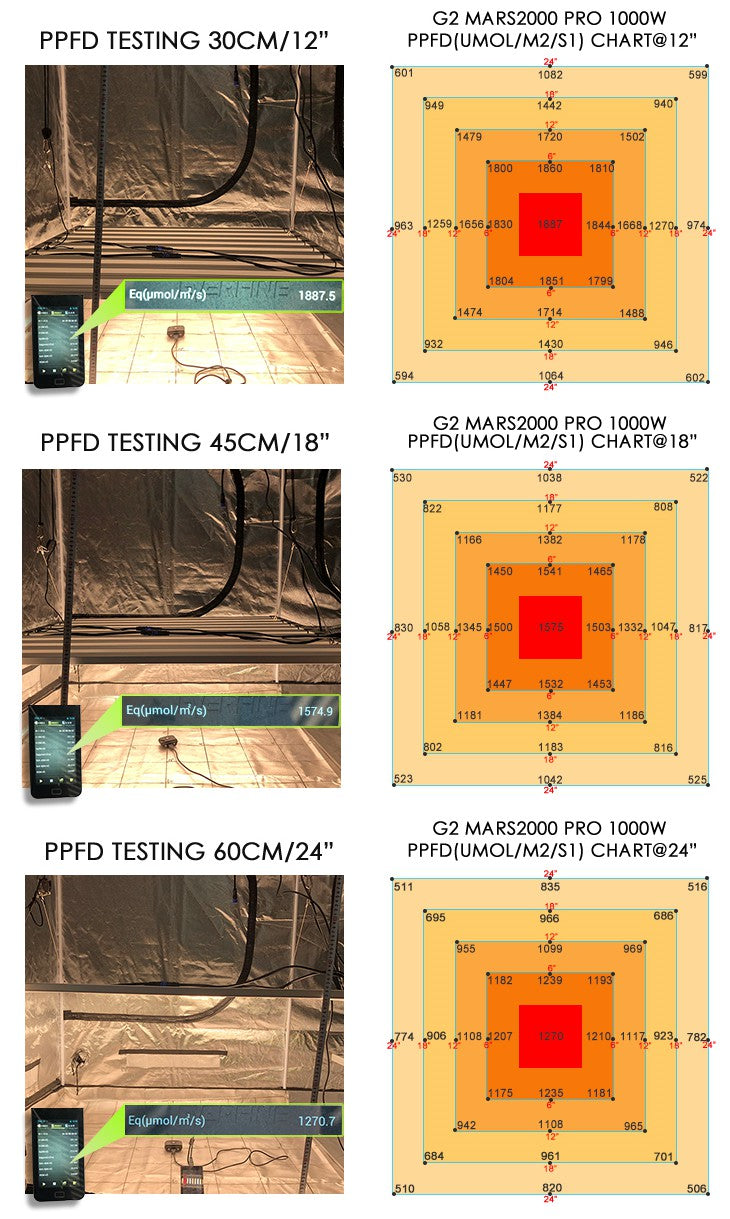
PhotonTek XT 1000W CO2 Pro LED VS ChilLED Growcraft X6 – 1000 Watt DIY Kit
May 12, 2021
Factors to Consider When Buying a 1000 Watt LED Plant Light
Actual Wattage
This is the actual amount of electricity the fixture will use. Three of the lights featured here always use the same wattage, while the other one has a range. That's because it gives you some control over the spectrum.
During the vegetative stage of growth, for example, plants don't need as much light as they do during flowering. A fixture that lets you turn off LEDs (or dial back their intensity) when they are not needed will save you money in electricity costs.
Light Output
1000w LED grow lights generally have an output equal to 900 watts of HPS light, despite what many manufacturers claim.
For our ratings, we gave 4 stars to the fixtures whose intensity is about equal to 900 HPS watts and 5 stars for an intensity better than a 1000 watt HPS bulb.
Coverage Area
This is the area in feet that the light will cover during flowering. During vegging, they can cover an additional foot or two in length and width. So a light that covers 4 by 4 feet during flowering will cover 5 by 5 or 6 by 6 feet during vegging.
PhotonTek XT 1000W CO2 Pro LED

PHOTONTEK LED is ready to bring you our most powerful grow light to date. With the perfect balance of quality and quantity, the XT 1000W will deliver the best light spectra on the market combined with ultra-high PPFD levels. Designed for a 5’x5’ space with use of CO2 supplement for maximum performance, the XT 1000W led gives growers the opportunity to massively boost yields without the need to increase space.
PHOTONTEK, creating better light for growers.
Only the highest-grade materials and components are used in P-TEK’s LED fixtures. Delivering safe, dependable light P-TEK fixtures have industry leading performance. By perfectly balancing a high quality, full spectrum light with highest intensity PPFD delivered through a multi-bar, Linear design. PHOTONTEK Creates the ultimate ceiling of light for the entire plant growth cycle, making these LEDs the smartest option for a higher and faster return on investment.
Producing extremely high levels of PPF output of 2925 µmol/s and a Photon Efficacy (fixture efficiency) of 2.9 µmol/J, XT 1000W CO2 Pro LED creates a homogeneous light spread at close distance from the crop canopy, resulting in outstanding results when used in 5’x5’ coverage indoor grow areas with Supplemental CO2 use.
Spectrum
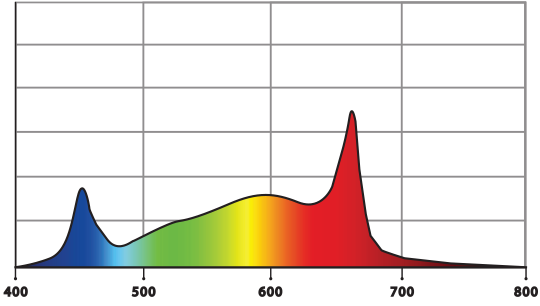
Specs
- Wattage draw: 1000W
- Efficacy: 2.9 µmol/J
- PPF: 2925 µmol/s
- Input Voltage: 120-270V
- Input Power (100%): 1005W (277V); 1025W (120V)
- Coverage Area: 5’x5’ with Supp. CO2; 6’x6’ without Supp. CO2 used at higher heights.
- Waterproof: IP65
- Lifetime: 60,000 Hrs
- Light Distribution: 120°
- Light Source: Higher Spec Osram and Lumileds Philips Diodes
- Dimmable: OFF-25%-50%-75%-100% with 0-10V Light Dimmer (Included)
- External Control: With Digital Controller
- Weight: 39.68 lbs
- Dimensions: 46.50’’x 42.95’’ x 4.16’’
- Spectrum: Full Spectrum
ChilLED Growcraft X6 – 1000 Watt DIY Kit

The ChilLED Growcraft X6 1000W DIY LED Grow Light Kit features a 6-bar configuration with two power drivers. Operating efficiently and providing a 5 x 5 feet standard coverage area, this Growcraft features a slim profile, passive cooled design that fits a variety of growing spaces.
ChilLED Growcraft LED Grow Lights are proudly designed and manufactured in the USA.
Maximum Efficient Power
This DIY LED grow light kit includes two Mean Well HLG-480H-48B power drivers that power the 6 light boards. Dimmable from 5% to 100% (50W to 1000W), they provide good light spread over a 5 x 5-foot area with a maximum coverage area of 6 x 6 feet.
- Light Engine Efficacy: 3.26 to 2.73 µmole/J
- Full System Efficacy: 3.08 to 2.58 µmole/J
- Total PPF: 2450 µmoles
Growcraft Yield Max Spectrum

Maximize your yields & profits with ChilLED LED Grow Lights. Switch from HPS to ChilLED and increase your yields & profits 30 - 70+% without adding any additional heat, energy costs or cooling requirements.
- DIY Friendly Modular Design – If you can dream it, you can build it!
- U Frame Structure Platform – Provides ready made framework – no need for drilling or tapping
- Innovative Rugged LED Light Bar System – Large footprint for even canopy coverage
- Slim Profile Passive Cooled Design – Only 1.375in thick & no moving parts
- Growcraft Yield Max Spectrum – 3rd Gen 2020 technology – maximum results
- Linear Power Control – 50W – 1,000W dimmable range
- Light Engine Efficacy – 3.26 μmole/J – 2.73 μmole/J
- Full System Efficacy – 3.08 μmole/J – 2.58 μmole/J
- Made In The USA – Finest quality materials and workmanship
Yearld Pro 660W LED Grow Light Bar VS ECO Farm MG8 660W Foldable LED Grow Light
May 11, 2021
If you are looking to start growing cannabis, you may be in a haze trying to figure out which is the most practical light to use on your plants. A single mistake in your decision can have devastating results on your cannabis. However, with the various grow lights in the market, how do you make the right selection?
Making the right selection involves having enough information about the different options available in the market and how the different lights they produce can be beneficial to your plants. When looking for Grow Light that is specifically for growing cannabis, you need to get a full cycle LED grow lights. However, you should be aware that you may only have to use it in the vegetative and blooming stages. Other factors you should also take into account include the area of coverage, the type of chips used, the amount of heat produced among other factors
What’s the best 660 watt LED Grow Light on the market?
The best 660 watt LED grow light will meet the essential requirements you need to get good yields from your cannabis plants. That’s sufficient intensity, good spectrum, and good coverage area.
I’ve researched and listed the best 660 watt grow lights and listed them for you below. First, make sure to figure out what type of 600 watt grow light you want:
Yearld Pro 660W LED Grow Light Bar

Top Features
- Industry-leading, dimmable and extremely efficient Meanwell driver
- High-efficiency Samsung LM301B White + Osram Red LEDs
- 4000K white true full spectrum enhanced with 660nm deep red for optimal canopy penetration
- Industry-top efficacy: 2.6 μmol/j
- Reliable passive-cooled design (no cooling fans required)
- Full Spectrum: Ideal for seedling to harvest growth
- Replaces a single-ended 1000W HID while only drawing 660W from the wall
- Auto-sensing power supply (AC 100-277V)
- 5-year warranty, 90-day replacement, 30-day return policy
Spectrum

Specifications
Watts: 660W (±5%)
PPF(μmol/s): 1716 µmol/s
Efficacy: 2.6 µmol/J @ 277 AC
Spectrum: 3920k white+660nm red
Color Rendering Index: 90
LED: Samsung LM301B & Osram
LED Count: Samsung*2816 & Osram*64
LED Lifespan: ≥50,000 hours
Driver: Meanwell ELG-240-48AB * 4
Driver Lifespan: ≥50,000 hours
Input Volts: Autosensing 120-277V
Dimmable: (0, 40%, 60%, 80%, 100%)
Master Controller: Yes (sold separately)
Daisy Chain: Available on request
Coverage Area: Veg: 6x6 ft, Flower: 5x5 ft
Mounting Height: 6'' - 18'' above canopy
IP Rating: IP65
Foldable: Yes
Dimensions: 46.46'' x 44.88'' x 2.76''
Weight: 24.4lbs(12KG)
Warranty: 5-year standard
ECO Farm MG8 660W Foldable LED Grow Light

ECO Farm Newest OSRAM LED technology Sunlight Spectrum, ETL listed certified, actual power 660W, provides PPF output(1848μmol/s), make you get 30% higher yield compare old purple led lights, to help you achieve maximum quality and quantity, which is much better than traditional grow systems.The best coverage of Veg is 50x50'', of flowering is 40x36''.
The most advanced design to effectively expand the light area. At the same time, the illumination is more uniform. This grow lamp is equipped with optical lenses on the LED beads, which makes the effective PPFD of our plant light improved, and it can also make the light more concentrated.
Spectrum

Specifications
| Nominal Wattage | 660W-8bar |
| Spectrum | Full Spectrum FSG(4000K) |
| PPF | 1848μmol/s |
| Efficacy | 2.8 μmol/J |
| Mounting Height | ≥6” (15.2cm) Above Canopy |
| Thermal Management | Passive |
| Dimming | 0-10V / 1-10V |
| Light Distribution | 120° |
| Lifetime | L90: >54,000 hrs |
| Dimming | 0-10V dimming, with dimming knob |
| Power Factor | >90% |
| Cords & Interfaces | Comes with 3m power cord with US plug, and 2pcs RJ14 interfaces. |
| Certifications | IP65, ETL, CE |
| Dimension | 43*42.7*2.8 inch |
| Weight | 21.6 lbs / 9.8kg |
| Warranty | 3 Years Standard Warranty |
